



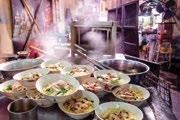















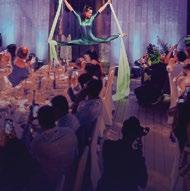



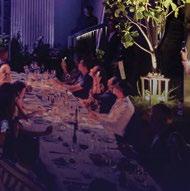









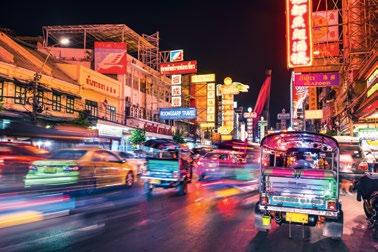

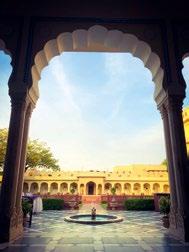


















































AH DECEMBER, THAT GLORIOUS MONTH AND TIME OF THE YEAR when wardrobes sparkle, and our diets becomes more suggestion than science.
For our nal issue of 2025, we’ve curated a celebration worthy of your most indulgent whims and wanderlusts. Our cover story on page 24, takes you to Bangkok, a city where serenity and vibrancy perform an elegant waltz. We explore its golden temples, secret rooftop bars, and those silk-soft mornings that begin with a lemongrass-scented breeze. Think of it as your invitation to the capital of contrasts, where mindfulness comes garnished with mango sticky rice.
If your compass points closer to home (page 36), Jaipur and Udaipur await: palatial, perfumed, and dripping with old-world grandeur. We guide you through festive hosting on page 50, that whispers effortless opulence, hiding the chaos behind the scene, beautifully. Wine tourism takes centre stage, tracing vintages from Spain to Italy on page 58.
Finally, we dine around the world showcasing the essence of traditional Christmas dinners, rediscovering the joy of long dinners, togetherness and even longer toasts on page 66.
So raise your glass to sparkle, spice, and the sweet art of not taking December too seriously.

Consulting Editor

DEBANJAN KUNDU
As AVP of Sales, GSO India, with the Shangri-La Group, Debanjan draws on over two decades of hospitality mastery. He leads sales strategy and market expansion across India, elevating the brand’s presence among high-net-worth leisure, weddings, and MICE clientele. His insights on curated loyalty programs for discerning corporate travellers are featured on page 22, reflecting his commitment to creating exceptional experiences as the ShangriLa name itself.
GP, General Manager of the prestigious JW Marriott Hotel Hong Kong, orchestrates a world-class team of hospitality professionals by masterfully guiding them toward strategic vision, operations, and guest experiences. A distinguished hotelier with almost three decades of expertise, he began his illustrious journey in Perth Australia. Renowned for his visionary leadership and commitment to sustainability, GP shares his insights on the shift and change in modern business travel, on page 23. CONTRIBUTORS


GP YEOW
































































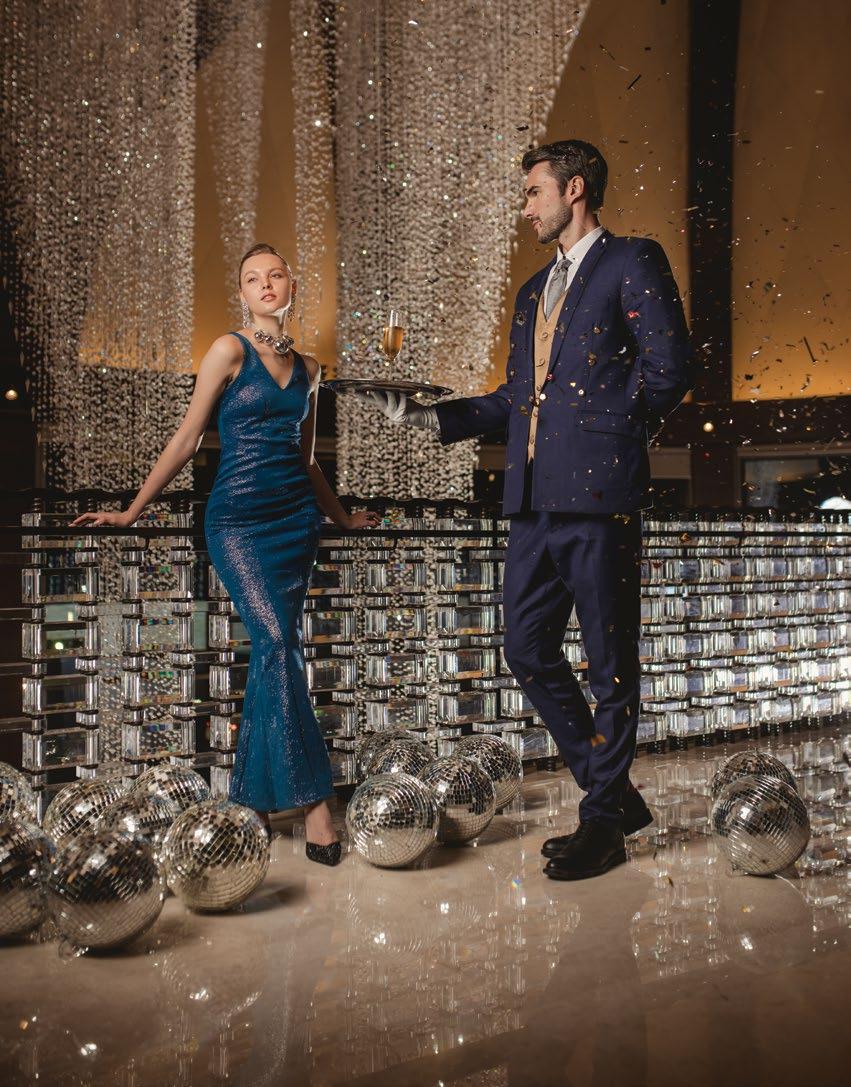
PUBLISHER & CEO RAVI LALWANI
MANAGING DIRECTOR JULIAN GREGORY
EXECUTIVE DIRECTOR MEENA LALWANI
EDITORIAL
CONSULTING EDITOR KHURSHEED MISTRY
PRODUCTION & DESIGN HEAD AMIT CHAVAN
FEATURES WRITER NAINA SARMA
SOCIAL MEDIA & FEATURES EXECUTIVE MARIA VERGHESE
CONTRIBUTORS DEBANJAN KUNDU, GP YEOW ADVERTISING
COMMERCIAL DIRECTOR RAVI LALWANI
EMAIL RAVI@PANACEAPUBLISHING.CO.IN
CONTACT
EDITORIAL TEL 022-40046646
EMAIL EDITORIAL@PANACEAPUBLISHING.CO.IN
WEBSITE BUSINESSTRAVELLER.COM TWITTER.COM/BT_IND
INSTAGRAM BUSINESSTRAVELLERIN FACEBOOK.COM/BUSINESSTRAVELLERINDIA
ADVERTISING TEL +91 9820022110
SUBSCRIPTIONS
TEL +91 9004015411
EMAIL SHMIRA@PANACEAPUBLISHING.CO.IN
PRINT SUBSCRIPTION 1 YEAR FOR JUST ₹2,400
Business Traveller India is published 11 times a year at our address (right). Business Traveller India is the first of its kind to be published in India. The magazine is entirely independent of all commercial interests within the travel industry. All rights reserved in respect of all content, articles, illustrations and photography published in Business Traveller India anywhere in the world. Reproductions or imitations are expressly forbidden without the permission of the publishers. Unsolicited manuscripts will not be accepted for publication and Business Traveller India accepts no responsibility for loss or damage to them. The opinions expressed by contributors are not necessarily those of the publishers, who cannot accept responsibility for any errors or omissions.
Business Traveller has the following international editions: Germany, Poland, Hungary, Asia-Pacific, China, India, Netherlands, North America, Middle East and U. K RNI NO.: MAHENG 2016/71766. Printed & Published by Ravi Lalwani on behalf of Panacea Publishing Pvt. Ltd. Printed at Indigo Press ( India ) Pvt. Ltd. Plot No.1C/716, Off Dadoji Konddeo Cross Road, Between Sussex And Retiwala Ind. Estate, Byculla ( East ), Mumbai - 400 027. Maharashtra and Published at 3 Hampton Court, 123, Wodehouse Road, Colaba, Mumbai 400 005.


TThai Airways is entering a new chapter in its journey toward smarter, more responsible aviation with the introduction of the Airbus A321neo, a nextgeneration aircraft built for short to medium-haul routes.
Powered by newgeneration engines, the A321neo achieves 15-20% lower fuel consumption, quieter performance, and reduced emissions, aligning with Thailand’s broader vision of sustainability and Suvarnabhumi Airport’s emergence as a regional aviation hub. This positioning not only elevates passenger comfort but also distinguishes THAI within the Asian market for its unique balance of innovation, design, and hospitality.


Connected above the clouds
On board, connection and content flow effortlessly through the SPI RAVE Ultra in-flight entertainment system, featuring 4K Ultra HD displays measuring 17.3 inches in Royal Silk and 13.3 inches in Economy. Bluetooth pairing allows passengers to use personal headphones for uninterrupted sound quality, while intuitive controls make every interaction feel natural.
Design intelligence in motion
The A321neo stands as the largest aircraft in the A320 family, and designed to deliver wide-body comfort in a narrow-body format, it sets new standards for regional travel. Its fully flat Royal Silk Class seats, high-speed Wi-Fi, and 4K in-flight entertainment system redefine what passengers can expect on shorter routes.
Royal Silk Class: Comfort with character
In Royal Silk Class, the cabin is fitted with Thompson Vantage seats that convert into 180-degree full-flat beds, stretching 77.7 inches in length.
The layout is an elegant 2-2 and 1-1 configuration that offers both ‘Double’ seats for couples and ‘Throne’ seats for solo travellers, ensuring privacy and personal space without compromise.
Each seat is equipped with a 45-inch pitch, ample storage, and large worktables, while the materials draw inspiration from Thai heritage with woven textures, subtle gold tones, and contemporary motifs that nod to the country’s artistic legacy. Travellers are also treated to Jim Thompson amenity kits and Marshall headphones, details that transform function into quiet and sophisticated luxury.
Economy Class: Thoughtful by design
Economy Class has been reimagined for comfort that feels purposeful rather than incidental. The RECARO ergonomic seats offer a width of 18.55 inches, 31inch pitch, and adjustable headrests, balancing support and space. Lightweight materials reduce cabin noise and increase efficiency, while the soft design palette evokes the calm precision that Thai Airways is known for.
High-speed connectivity comes via the Airbus HBC+ system, powered by SES/NSG satellites, supporting both Ka-band and Ku-band coverage for global consistency. Internet speeds reach 200300 Mbps, making it possible to stream, work, or stay in touch without interruption. Through THAI Sky Connect, passengers can stay online throughout their journey.
Royal Silk travellers receive a 60-minute complimentary Surfing package, while Royal Orchid Plus members enjoy tiered privileges, from unlimited access for Platinum members to 30 minutes for Silver and Basic tiers. Additional packages are available for purchase mid-flight, ensuring every passenger remains connected even at 30,000 feet.
A commitment to sustainable excellence
Setting new benchmarks for sustainable flight, the first A321neo is expected by the end of 2025. By combining advanced engineering, elegant Thai design, and an unwavering focus on passenger experience, Thai Airways continues to deliver what it has promised for generations: travel that is both sophisticated and sincere, Smooth as Silk.
TRAVEL
Changi Airport and Jewel launch Disney themed festivities
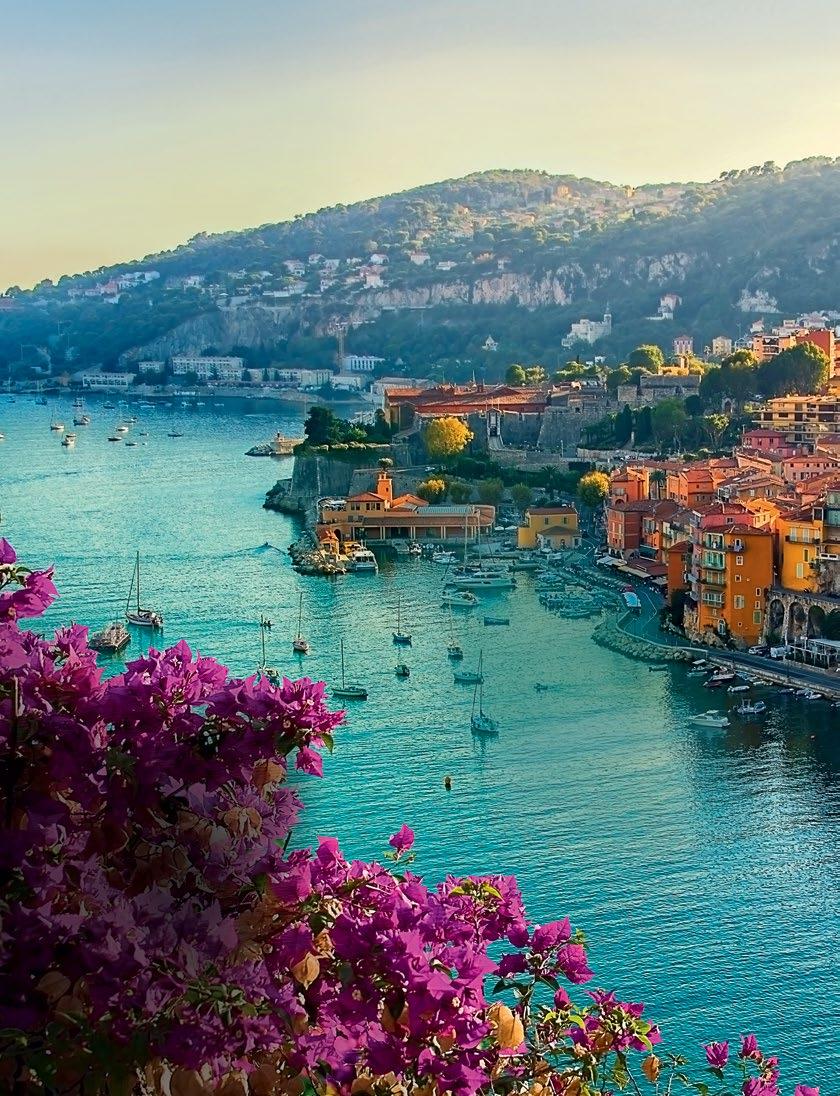
AIRLINES
Air India – Vistara, Etihad Airways and Hong Kong Airlines
HOTELS
JW Marriott Bengaluru
Electronic City and Radisson Hotel Group
SUSTAINABILITY
Biodiversity for well-being and sustainable living


WORDS MARIA VERGHESE
Tucked between the cliffs of the French Riviera and the vast blue expanse of the Mediterranean, Monaco glimmers like a secret well kept. Barely two square kilometres in size, it carries the allure of a place far greater, where elegance and exhilaration exist in perfect poise. The sunlit curve of the harbour shimmers with yachts that seem to float between sea and sky, while terraced gardens spill down hillsides fragrant with bougainvillaea and citrus. From its vibrancy to the quiet dignity of the royal attraction, every inch is steeped in a legacy of luxury. Here, days unfold with cinematic precision: sunlight glancing off sea glass, the hush of waves beneath limestone cliffs, the hum of engines on the Grand Prix circuit, a melody of movement and grace.



Life in Monaco is a choreography of indulgence and ease. Mornings begin on shaded terraces overlooking the sea, coffee meeting coastline in an unhurried ritual. Afternoons might be spent drifting between galleries, haute couture ateliers, and oceanfront bistros where rosé gleams like liquid gold. Come evening, the principality transforms; terraces flicker with candlelight, and the scent of salt and jasmine carries through the air as music drifts from open balconies. The cuisine here celebrates the Riviera’s abundance. Mediterranean seafood dressed with olive oil and herbs, market-fresh produce from Provence, and the restrained artistry of Michelin-starred tables honour place and palate. Beneath its polished exterior lies something deeper, a rare balance between glamour and grace. Monaco’s sophistication is not loud, but quietly assured, found in its sense of order, its devotion to beauty, and the gentle rhythm of a life shaped by sea and sun. In this haven of light, time seems to move differently: not slower, but finer, distilled to moments that gleam like the horizon at dusk. Monaco is not merely a retreat, but a revelation where opulence meets serenity, and every detail, from the curve of the coastline to the clink of crystal, reminds you that perfection need not be vast to be complete.
Changi Airport and Jewel have introduced an extensive Disney-themed festive programme running across multiple terminals and Jewel’s attractions. The centrepiece is a new Light & Music Showcase at Jewel’s Rain Vortex inspired by Disney Cruise Line, featuring themed medallions and characters from Disney, Pixar, and Marvel. At Terminal 3, a 6.5m ship installation offers photo opportunities, supported by four themed popup sets highlighting areas from the upcoming Disney Adventure cruise ship. Additional displays include character topiaries across Terminals 1 and 2, daily snow sessions, and scheduled meet-and-greets.
Terminal 3 Basement 2 features an underwaterthemed zone with interactive installations and a beach-themed DIY craft area offering Disney Cruise Line-branded merchandise personalisation. A Disneythemed carnival provides game booths, while a stamp rally encourages visitors to collect seven stamps for rewards. At Jewel, installations include a 16m Christmas tree, character topiaries, themed zones in Canopy Park, snowfall sessions, and airport-exclusive seasonal merchandise. Visitors may also enter lucky draws offering Disney cruise prizes.



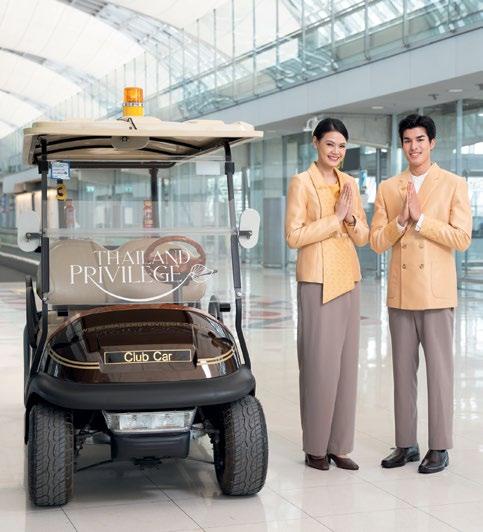
There comes a moment in the life of every global Indian when the definition of “success” evolves. When it becomes less about accumulation and more about curation, of time, of well-being, of the environments that shape us. Increasingly, the most valued luxury is not excess, but ease.
In that quiet shift, Thailand has emerged as a natural second home for Indians who have travelled widely, lived sumptuously, and now seek a place where life feels balanced. In Pattaya, a growing Indian community has become an integral part of the city’s social fabric, supported by formal organisations, local businesses and cultural events. It reflects the trust Indians place in Thailand as a home away from home, celebrated through occasions such as Diwali, Holi and the International Day of Yoga.
Here, mornings carry the freshness of the sea in Phuket, weekends unfold along the shores of Koh Samui or Krabi, and daily life flows with a confluence of culture, cuisine, and nature. Bangkok’s creative energy and global dining, Chiang Mai’s mindful calm, and the country’s instinctive hospitality come together to create a way of living that feels both elevated and reassuringly familiar.
Part of Thailand’s magnetic pull lies in a cultural kinship that feels almost intuitive. The Indian sensibility values community, respect, spirituality, family closeness, generosity, and the joy of shared meals, all qualities that are also imbued in Thai culture.
For Indian HNWIs, entrepreneurs, and multi-city citizens, Thailand offers something rare: a second home that honours both ambition and inner balance. It is an Asian hub with global access, serving as a base for business across ASEAN, a gateway to travel throughout the region, and a destination that prioritises wellness and longevity at its core.
Thailand has recently been recognised as the Most Popular International Wedding Destination 2025 at the TTJ MICE Mart Awards in India, reaffirming its standing as a place where milestones and meaningful celebrations naturally find a home. It has also been cited by the U.S. Department of State as one of the world’s safest destinations, further strengthening its appeal for families seeking security, comfort and a nurturing environment. This is a ‘return on life’ investment rather than simply a transactional one.








The only friction to this dream, historically, has been the complexity of long-term residency. Visas, renewals, paperwork and the administrative weight of settling abroad can take away from the experience. In response, Thailand introduced Thailand Privilege Card, a state-endorsed long-stay programme created for individuals who appreciate privacy, clarity and a more elevated way of living.
Thailand Privilege Card is a long-stay programme created for individuals who value refinement, comfort and a thoughtful standard of service. It grants multi-year, multiple-entry hassle-free residency for 5 to 20+ years, with the freedom of unlimited entries and extended stays.
From the moment one arrives, the experience unfolds with quiet composure. Airport VIP Services begin at the gate with a personal meet-and-greet, followed by electric cart assistance where available, to ease movement through the terminal.





Immigration is handled through priority lanes and select arrival lounges offer a calm pause before stepping into the city. Curated airport transfer services complete the arrival sequence with the same attention to detail.
Once settled, Elite Personal Liaisons provide support that extends into daily living. Guidance for 90-day reporting and key government formalities is provided, along with assistance in opening a Thai bank account and obtaining a Thai driving licence. A 24/7 multilingual contact centre ensures that clarity and support are always within reach, allowing life in Thailand to take shape with confidence and ease.
Membership also unlocks five lifestyle privileges: Stay, Travel, Leisure, Health & Well-being and Wealth, each created to enhance the way you experience Thailand. These include hotel privileges with savings of up to 50% and complimentary nights at leading luxury properties, preferential travel options across partner networks, and premium access to shopping, entertainment, concerts and co-working spaces. Health benefits range from complimentary check-ups to significant savings at world-class hospitals and more

than 100 partner spas, while wealth privileges offer advisory support, networking opportunities and a suite of exclusive member advantages.
MEMBERSHIP TAILORED TO YOUR WAY OF LIVING
Thailand Privilege Card offers five tiers of membership, each designed to reflect how deeply one wishes to anchor their life in Thailand. Entry begins from a minimum of USD 20,000 (exchange rates may vary), ranging from flexible five-year access to programmes that extend beyond two decades. Whether one intends to visit regularly, divide time between cities or create a more rooted chapter in Thailand, the tiers allow individuals to choose the level of immersion that aligns with their lifestyle vision.
A LIFE SHAPED WITH INTENTION
To embrace Thailand is to choose a life attuned to balance, beauty and mindful living. It appeals to those who value mornings that begin with clarity, surroundings that nurture family and self, and a sense of home that extends across borders.
For global Indians shaping their next chapter, the Thailand Privilege Card offers a thoughtful pathway into a life that feels gracefully lived. One where each day carries a quiet sense of contentment and the freedom to savour what truly matters.

Start your hassle-free life in Thailand - Register now

THE MERGER OF AIR INDIA LIMITED AND VISTARA - TATA SIA AIRLINES LTD. , completed in November 2024, marked a milestone in India’s aviation industry, creating one of Asia’s largest full-service carriers under the Air India brand. The unified airline operates a combined fleet of around 300 aircraft, covering 312 routes with more than 8,300 weekly flights. The integration consolidates the Tata Group’s aviation portfolio, streamlining operations and leveraging synergies across fleets, networks, and service standards.
This merger also aligns with Air India’s five-year Vihaan.AI transformation programme, aimed at establishing the airline as a leading global carrier. Over the past year, progress has been made in harmonising employee structures, passenger services, and operational systems. With combined strengths in domestic and international markets, the new Air India enhances India’s position as an aviation hub, offering expanded connectivity, upgraded inflight experiences, and strengthened competitiveness against global peers in both longhaul and premium travel segments.


ETIHAD AND HONG KONG AIRLINES have launched a new strategic partnership featuring a codeshare agreement and reciprocal loyalty benefits, enhancing connectivity between the Middle East and Asia. Under the codeshare, Etihad’s EY code will appear on Hong Kong Airlines flights between Hong Kong and Bangkok, while Hong Kong Airlines’ HX code will be placed on Etihad’s services between Abu Dhabi and Bangkok, extending convenient access to key destinations across both networks. The partnership also includes a reciprocal loyalty programme arrangement, allowing members of Etihad Guest and Fortune Wings Club to earn and redeem miles interchangeably when flying with either airline. This collaboration significantly strengthens travel options between Hong Kong, the UAE, and beyond, aligning with both carriers’ network expansion strategies. By combining Etihad’s extensive global reach with Hong Kong Airlines’ strong regional presence, the partnership delivers greater flexibility, seamless connectivity, and enhanced travel rewards for passengers across Asia and the Middle East.
MARRIOTT INTERNATIONAL has announced the signing of JW Marriott Bengaluru Electronic City, marking the debut of the luxury brand in Bengaluru’s IT corridor. Set in Electronic City, the property will cater to both business and leisure travellers, leveraging proximity to major technology parks and industrial hubs. Details on room count and facilities were not disclosed, but JW Marriott’s signature high-end amenities are expected, including premium dining, event spaces, and wellness offerings.
The signing aligns with Bengaluru’s growth as a business and leisure destination, reinforcing Marriott’s strategy to expand its luxury portfolio in strong-performing Indian markets. The upcoming flagship property joins Marriott’s broader Indian footprint and reflects confidence in demand for upscale accommodation catering to corporate travellers, international visitors, and high-net-worth leisure guests. Reservations and formal opening timelines will be announced at a later stage.


RADISSON HOTEL GROUP is launching its first Radisson Collection property in Maharashtra through a new luxury hotel signed near Navi Mumbai International Airport in Panvel. Scheduled to open by Q1 2030, the 350-room resort will include curated dining venues, rooftop bars, a world-class spa, cutting-edge wellness facilities and flexible event spaces tailored for conferences, weddings and highend leisure stays.
The development supports Radisson’s strategy to bolster its luxury portfolio in India’s fastest-growing business and lifestyle corridors. Located in one of Western India’s most important infrastructure hubs, the hotel aims to serve both corporate travellers and upscale leisure guests, blending global refinement with local context. This landmark signing flags Radisson’s long-term commitment to Western India and reflects the pace of branded hotel growth as India’s hospitality demand intensifies.
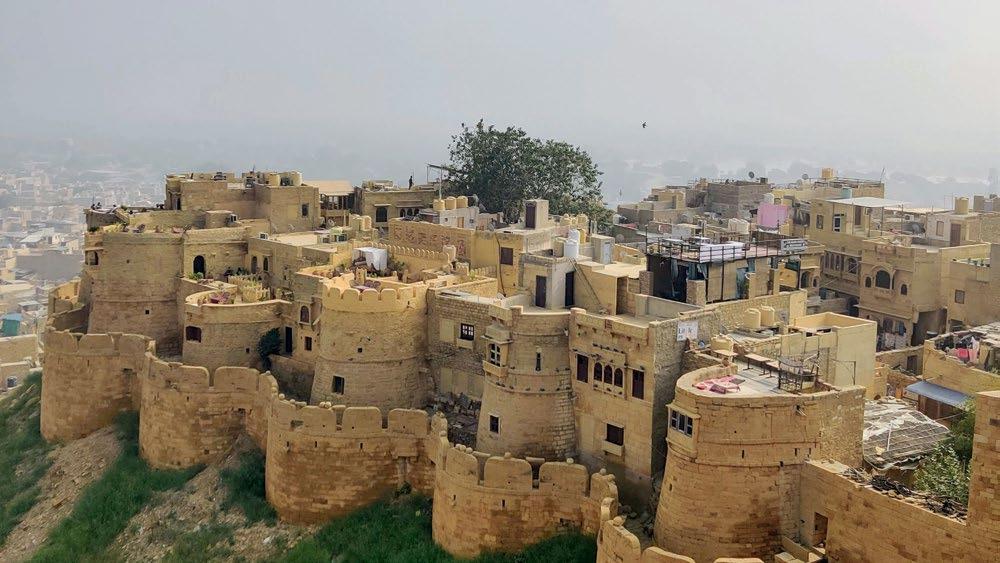
has announced its debut in Rajasthan with the signing of The Leela Jaisalmer, developed in partnership with The Godwin Group. Set across 30 acres near the UNESCO World Heritage, listed Jaisalmer Fort, the luxury desert resort will feature 80 guest rooms, suites, and tented villas designed to capture the grandeur of Rajasthan’s royal heritage. Scheduled to open in 2026, the property will include a man-made lake, expansive spa, multiple dining venues, and state-of-the-art event spaces for
The new opening marks a strategic expansion of The Leela’s luxury portfolio, strengthening its presence in India’s high-end leisure segment. With 13 operational properties and several in development, the brand aims to expand to 23 hotels and over 5,000 keys within the next three years. The Leela Jaisalmer reinforces the group’s commitment to creating immersive, destination-driven experiences that celebrate India’s cultural and
TAJ WELLINGTON MEWS, CHENNAI has become South Asia’s first luxury serviced residence to receive the EDGE Zero Carbon Certification, awarded by IFC-backed EDGE for properties that demonstrate net-zero onsite carbon emissions. The property achieved an EDGE Advanced rating by exceeding required benchmarks, more than 40% energy savings and over 20% reductions in water use and materials. The certification aligns with Indian Hotels Company Ltd’s Paathya ESG framework and reflects the residence’s commitment to sustainable design, construction, and operations.
Managed by an all-women leadership team, the development sets a precedent in India’s upscale hospitality segment by integrating environmental stewardship with luxury service residence living. This milestone reinforces Taj Wellington Mews’ position as a benchmark for green hospitality in the region and supports the hospitality group’s broader push toward responsible operations and benchmark certifications in its growing portfolio.







Tea, long revered as a symbol of ritual, has gracefully transcended its humble origins to become a global emblem of luxury, wellness, and sophisticated living.
Celebrated for centuries across Asia, Europe, and beyond, tea embodies the art of mindfulness, offering a serene interlude amid the bustling pace of modern life. Each cup delivers not only comfort and pleasure but also an array of wellness benefits; from antioxidant-rich blends that support vitality, to calming infusions that enhance focus, clarity, and emotional equilibrium. Tea is more than a beverage; it is a quiet indulgence that enriches and empowers daily life.

Across international markets, tea’s popularity continues to flourish, propelled by a discerning appreciation for artisanal quality and provenance. Connoisseurs seek rare single-origin leaves, hand-harvested and meticulously
processed, that reflect craftsmanship akin to fine wines. Beyond its sensory allure, tea resonates socially and culturally. It graces formal gatherings, accompanies reflective solitude, and inspires ritualistic preparation that fosters connections. Its versatility, enduring elegance, and therapeutic qualities have cemented tea as a symbol that transcends geography, generations and trends.
As global markets increasingly embrace premium blends, ceremonial traditions, and wellness-focused infusions, tea remains the quintessential beverage of that harmonises well-being and worldly sophistication. Luxury tea brands now present bespoke blends, limited editions, and exquisitely designed packaging, appealing to those who value taste and aesthetics. From boutique tea salons in Paris to ceremonial tea houses in Kyoto, tea has become a lifestyle statement.





Biodiversity, the intricate mosaic of life on Earth, is far more than a scientific concept. it is the foundation of sustainable development and human well-being. From the lush rainforests of the Amazon to the delicate coral reefs of the Pacific, the richness of species, ecosystems, and genetic variation sustains the natural balance upon which humanity depends. Each organism, no matter how small, plays a vital role in maintaining ecological harmony, ensuring food security, and regulating climate systems, forming a living architecture that nurtures life itself.
The preservation of biodiversity is essential not only for environmental resilience but also for the quality of human life. Diverse ecosystems provide clean air, pure water, fertile soil and natural resources that underpin health, productivity, and prosperity. In an era of rapid urbanisation and industrial growth, safeguarding biodiversity becomes an investment in the long-
term sustainability of communities and economies worldwide.
Globally, biodiversity supports innovation and creativity, inspiring solutions from bio-inspired design to pharmaceuticals derived from rare plants and microorganisms. It is a source of cultural identity, recreation, and aesthetic pleasure, reminding humanity of its deep connection to nature. Protecting biodiversity is thus not merely a moral imperative but a strategic approach to ensuring intergenerational well-being.
As sustainable development gains momentum, integrating biodiversity conservation into policy, urban planning, and corporate responsibility is paramount. By valuing and nurturing the richness of life on Earth, societies unlock a future where human prosperity and natural splendour coexist harmoniously.
Biodiversity is the ultimate luxury of our era; an irreplaceable resource that sustains life, elevates human experience, and shapes the path toward a resilient and thriving world.





WORDS NAINA SARMA
Perched amid rolling hills and drifting clouds, Shillong is a city that listens to its own song. Rain-washed streets, guitar chords in the air, and the scent of pine define its rhythm; part nostalgia, part rebellion. Between music, mist, and marketplaces, the hill town reveals itself slowly, a place less seen than felt, where every echo sounds a little like home.



Shillong’s spirit lies in its music and its people. It’s there in the guitars and khasi drums that echo from open cafés, in the street murals that bloom overnight, in the quiet pride of its people. The Don Bosco Museum weaves together the stories of the Northeast, textiles, totems, and tools that speak across languages. Come evening, small bars turn into stages; a singer’s voice might rise over the rain. Colonial bungalows sit beside glass-fronted homes, not in contrast but in conversation. The city’s pulse is art and ancestry intertwined, a place that doesn’t perform its culture but truly lives it, note by note.
Nature begins almost without announcement. A drive to Laitlum Canyon feels like falling off the map with cloud, wind, and silence stretching in every direction. Ward’s Lake offers a gentler pause: pine shadows on water, an old wooden bridge creaking underfoot. For those with a few hours more, treks to Shillong Peak or the waterfalls near Sohra reveal the land’s raw pulse with mist clinging between meetings or monsoon drizzles, the city gives you a reason to look


The city’s pulse is art and ancestry intertwined, a place that doesn’t perform its culture but truly lives it, note by note
Shopping here, has the unhurried grace of conversation. At Police Bazaar, traders call out over the scent of roasted corn, selling handwoven shawls, bamboo baskets, indie tees, and loose-leaf teas. A few hills away, Laitumkhrah’s boutique corners showcase the city’s young design streak, with Khasi weaves reimagined into sleek jackets, and silver jewellery shaped with old-world precision. Those chasing something rarer find it in the villages of Mawlynnong or Smit, where artisans work with time rather than against it. Each object here carries a fingerprint, handmade, storied, quietly enduring.
Culinary exploration here is as much about comfort as it is about curiosity. At Café Shillong, jazz hums softly as plates of pork ribs and momos arrive steamin while Dylan’s Café pays tribute to the city’s musical soul with hearty breakfasts and locally sourced coffee. The city’s food scene stretches beyond nostalgia, with restaurants like Smoky Falls Tribe Coffee and Deja Brew, that pair global café culture with homegrown ingredients. At the same time, Khasi kitchens in Laitumkhrah serve jadoh, tungrymbai, and bamboo shoot curries rich with history. Each meal, whether shared in a modern diner or a family-run eatery tucked down a side street, carries the warmth and heart of the place and people.

Crafted from Italy’s finest white diamond truffles, this gelato by Cellato melds two cheeses with sake lees for delicate complexity. Snow-like truffle and Parmesan shavings, kissed with gold leaf, enhance its silken depth. Served alongside aromatic truffle oil and a handmade Kyoto spoon, crafted with sacred temple techniques, each bite unfolds as a rare harmony of cultural heritage and transcendent flavour.
In the world of fine dining, indulgence often finds its most exquisite expression in dessert, the final act where craftsmanship, rarity, and art converge. They transcend sweetness, embodying luxury itself; measured not merely in ingredients, pricing or its exclusivity, but in imagination and ingenuity. These edible masterpieces are meant to be admired as much as they are savoured, each one reflecting the deepest sense of beauty and ceremonial splendour.


An homage to Sri Lanka’s iconic stilt fishermen, this exclusive creation pairs Italian cassata infused with Baileys, vibrant tropical compote, and Champagne sabayon adorned in gold. A hand-sculpted chocolate fisherman balances atop, bearing an 80-carat aquamarine of rare brilliance. Presented with bespoke glass cutlery crafted exclusively for The Fortress, this private indulgence transcends dessert, converging in an unforgettable heritage.
Manyokan Hitachi is an extraordinary steamed yokan jelly featuring 80% of Japan’s finest Iinuma chestnuts, cold-aged for two weeks to heighten natural sweetness. Each chestnut is hand-peeled, leaving subtle traces of bitter skin to enrich flavour. Eleven chestnuts grace every confection, paired with the eclectic Hokkaido Tokachi red bean paste. A five-day aging perfects the blend, creating an unparalleled harmony of texture, sweetness, and aroma. A true masterpiece of artisanal confectionery.
Crafted for connoisseurs, where ritual meets detail


For the serious enthusiasts, the Cigar Humidor from The Bar Collective is a precisionengineered storage solution that protects the full flavour profile of prized cigars. This model, made by EuroCave, provides optimal conditions, maintaining stable humidity and temperature behind its sleek full-glass or framed door variants.
The Cigar Cutter Monogram 1872 Black from S.T. Dupont exemplifies understated elegance in smoking accessories. Crafted in metal with a glossy black lacquer finish and gold accents, its stand combines strength and sophistication. The compact size makes it ideal for travel or tabletop display, offering aficionados a minimalist base that elevates the art of cigar enjoyment with timeless French craftsmanship.


This crystal ashtray from Versace Home’s Medusa Lumière collection features a sculpted three-dimensional Medusa head at its base. Crafted in fine crystal, it exudes sophistication while serving as both a functional piece and a collector’s object. Measuring 16 cm across, it brings luminous elegance to coffee tables, lounges, or bar settings as an emblem of Italian grandeur.






or years, loyalty programs were defined by points charts, blackout dates, and a predictable cycle of “earn and burn.” But the expectations of today’s high-value corporate traveller have shifted. They now look for more than transactional rewards, they seek exclusivity, flexibility, and meaningful experiences that acknowledge their individuality and business needs.
Meticulously designed loyalty journeys for discerning jetsetters embracing exclusivity and unparalleled privileges
FGlobal standards are changing fast. In this evolving landscape, Shangri-La has taken bold strides with its Shangri-La Circle (SLC) program, which epitomises where loyalty must go next.
Launched in 2022, SLC prioritises flexibility - members can earn and redeem seamlessly with no blackout dates, using cash, points, or both. The system is simple: 15 points equal one US dollar, eliminating the confusion often tied to redemption charts. Beyond simplicity, members enjoy recognition not just through tier upgrades but through curated privileges: exclusive dining offers, insider access to cultural events, and personalised touches that make each stay memorable.
For top-tier travellers, ShangriLa has layered in Polaris-level benefits such as check-in at any time, guaranteed late check-out, luxury car services, and even meet-and-greet at the aerobridge in select airports. Add to that, the ability to extend Diamond status to a family member, access hotel facilities without a stay,
and invitations to private global events, from whiskey pairings to art exhibitions. These benefits underline that today’s loyalty is about lifestyle, not just hotel nights. What makes this approach stand out is its foresight. Research shows families and younger business travellers want loyalty schemes that integrate professional and personal life. Shangri-La has responded with Questers Rewards, a family-centric extension that allows members to co-create experiences with their children—an
innovation almost unheard of in the industry.
Ultimately, loyalty programs are no longer side projects, they are the backbone of hospitality marketing and strategy. They cultivate repeat business, generate invaluable data on guest behaviour, and turn fleeting stays into longterm relationships. In a competitive market where choice is abundant, programs like Shangri-La Circle demonstrate how loyalty can be reimagined: not as a transaction, but as a journey.
Beyond simplicity, members enjoy recognition not just through tier upgrades but through curated privileges: exclusive dining offers, insider access to cultural events, and personalised touches that make each stay memorable




usiness travel has returned, but with a renewed sense of intention. The suits are lighter, the schedules leaner, and the expectations deeper. Where once the measure of success was how many cities one could conquer in a week, the new metric is how purposeful each journey feels. Corporate travellers today seek more than efficiency; they seek connection, clarity, and balance.

Hybrid work has redrawn the mobility map. Teams meet online for the routine, but they travel for what matters, like moments of alignment, creativity, and trust that no video call can replicate. Conferences, client visits, and leadership offsites have become experiences for building relationships rather than ticking boxes.
Technology continues to shape this evolution. Digital tools make it possible to work anywhere and stay connected everywhere. But technology’s real strength lies in freeing travellers to focus on collaboration and creativity. Seamless connectivity, flexible check-ins, and intuitive in-room features are now expectations, allowing guests to move effortlessly between work and rest. At JW Marriott Hotel Hong Kong, our guests arrive ready to perform, but what they remember most are the moments of calm and care that occur between meetings, and those quiet gestures that remind them they’re being looked after.
Global awareness of wellness shapes travel preferences and corporate policies
Wellness, too, has moved to the heart of business travel. After years of blurred boundaries between work and life, travellers now value balance as much as productivity. They seek spaces that restore both body and mind. At JW Marriott Hong Kong, wellness is not an add-on but an atmosphere. Right from the scent of calming botanicals that greet guests in the lobby to herbs freshly sourced from our JW Garden for mindful dining. Each detail encourages guests to pause, breathe, and be present, creating a sense of groundedness amid the constant rhythm of modern travel. Beyond
physical rejuvenation, wellness here is about mental stillness and emotional renewal. Quiet mornings overlooking Victoria Harbour, unhurried meals that nourish as much as they delight, and spaces designed to soothe the senses. It’s a philosophy that reminds guests that well-being is not something to schedule, but something to return to, wherever their journeys
Equally transformative is the rise of sustainability. Companies and travellers alike are more conscious of their impact, choosing partners that align with their values. We’ve woven eco-conscious practices into our daily operations, from paperless and plastic-free solutions to energy efficiency and watersaving measures. Guests hosting events can join our carbonoffset programme, ensuring every meeting is a gesture of purpose. We also take pride in responsible sourcing, sustainable menus, and thoughtful food waste management. Even our central location, easily reached by public transport, supports lowcarbon commuting and a closer connection to the city around us.
The future of business travel is not defined by distance, but by depth. It calls on hoteliers to craft experiences that evoke presence, that help travellers find focus amid movement, serenity amid schedules, and meaning within the miles they cross. In this new era, true luxury is no longer measured in scale or splendour, but in the awareness of purpose, of people, and of the world we move through.









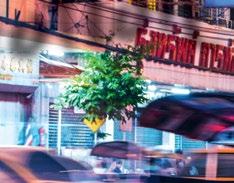

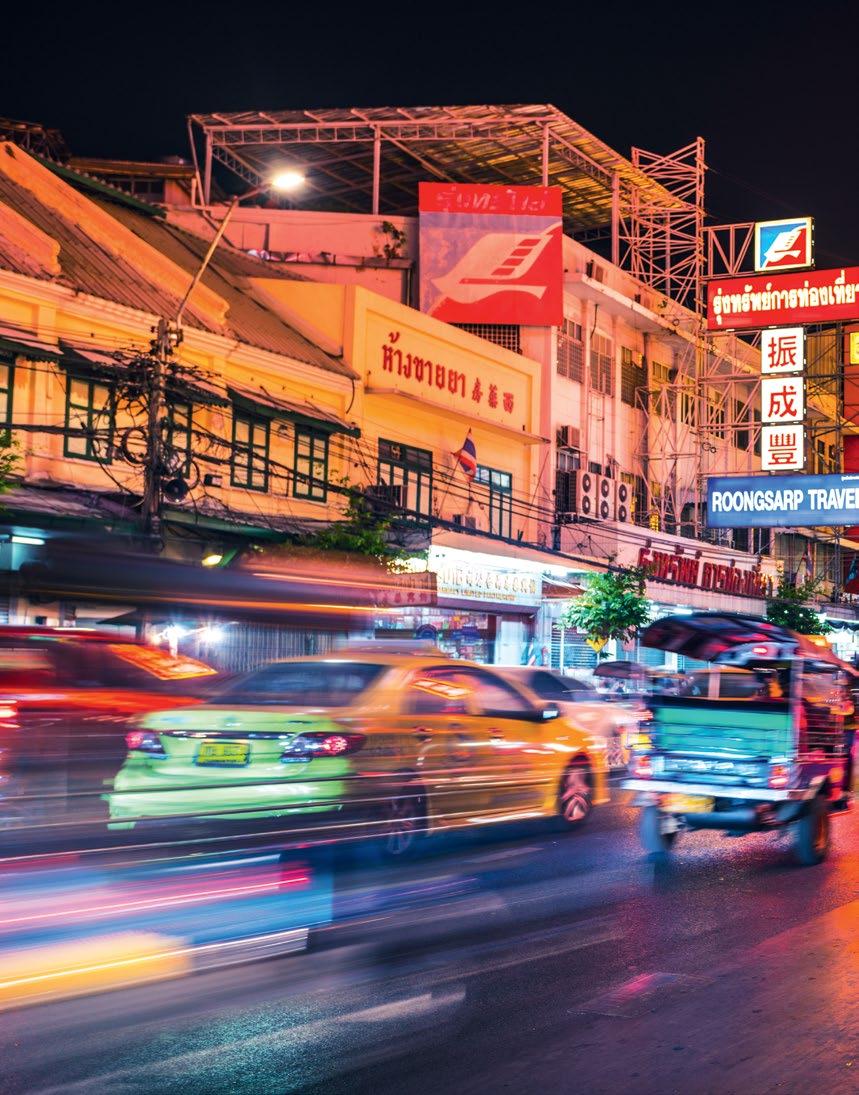
Bangkok is a city that unfolds in layers, rewarding curiosity at every turn. Mornings begin with saffron-robed monks collecting alms in quiet neighbourhoods, and by midday you’re swept into a whirl of street-side kitchens, riverside walks, and creative enclaves reimagining Thai tradition. The city blends deep-rooted heritage with a youthful, expressive energy that shapes its art, food, design, and nightlife. Longtail boats glide across the Chao Phraya River, linking historic temples with vibrant markets and modern districts alive with fashion, music, and contemporary culture. Whether wandering through its landmark quarters, discovering emerging talent in galleries and cafés, or watching the city shimmer from a rooftop, Bangkok draws you into its rhythm. It is a metropolis that invites you to taste, observe, explore, and return for more.




The Chao Phraya comes alive this season with Vijit Chao Phraya 2025, The Light of Siam: The Mother of the Nation, a luminous tribute to Her Majesty Queen Sirikit, The Queen Mother. Honouring her lifelong dedication and benevolence to the Thai people and preservation of Thailand’s natural resources, arts, and cultural heritage, the festival lights up the riverbanks from November 9 to December 23, 2025, from 6:00pm to 10:00pm. Light installations, artistic projections, and cultural displays create an atmosphere of unity, gratitude, and quiet reverence, turning Bangkok’s iconic waterway into a shimmering celebration.
Tucked behind a screen of tropical greenery, the Jim Thompson House feels less like a museum and more like a home paused in time. Traditional Thai teak structures flow into serene courtyards, filled with art, textiles, and collected treasures that reflect Thompson’s eye for craftsmanship. The space is intimate, as if its owner might walk back in at any moment! While preserving heritage, the house captures a spirit of curiosity and cross-cultural exchange that still echoes through Bangkok’s creative scene.
Experience a sensory shift as you step into Wat Pho. The wafting incense in the air, soft chanting, and the gleam of gold catching the light. The Reclining Buddha stretches an astonishing 46 metres, serene and languorous, inviting visitors to slow their own pace. Delicate mother-of-pearl inlays on the feet tell stories of Buddhist teachings. At the same time, the surrounding temple complex, with its courtyards and stupas, encourages exploration rather than simply being a quick photo stop.
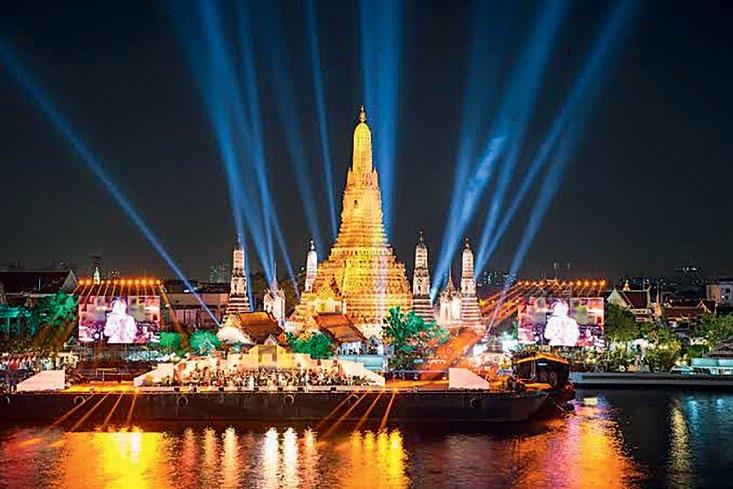



The Grand Palace is Bangkok’s ceremonial heart, where Thailand’s royal history reveals itself through intricate craftsmanship and layered symbolism. Gilded roofs, ornate pavilions, and sacred spaces are unveiled as visitors step through the complex, each corner echoing tradition and statehood. A visit here is not simply sightseeing, but is a moment of reverence in the city’s cultural narrative, best approached with time, awareness, and respect for the palace’s enduring significance.
A scenic escape from the city’s intensity, Silverlake Vineyard offers gentle hills striped with vines, a lake that shimmers at sunset, and a pace that slows the pulse. Visitors can wander through the estate, taste locally produced wines, or settle into a terrace overlooking the landscape with a glass in hand. It’s a Thai countryside interlude that pairs well with leisurely conversation, good company, and the pleasure of an unhurried afternoon.
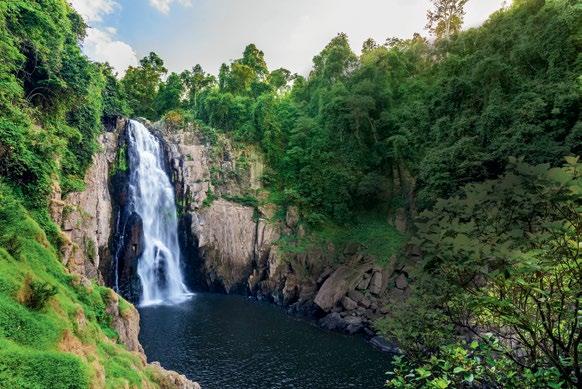
KHAO YAI NATIONAL PARK
A few hours beyond Bangkok, Khao Yai National Park shifts the scene entirely, trading neon for dense forests and city soundtracks for birdsong. Waterfalls, hiking trails, and abundant wildlife offer a refreshing immersion into nature, whether exploring on foot, joining a guided night safari, or simply breathing in the cool mountain air. It’s a reminder that Thailand’s beauty is not only cultural and culinary, but deeply rooted in the wild landscapes that shape its spirit.
Siam Paragon delivers a polished, cosmopolitan retail experience at the heart of Bangkok’s style circuit. International fashion houses, gourmet supermarkets, luxury car showrooms, and refined dining galleries sit under one roof. It’s the city’s statement mall, lively, elegant, with something always new for the curious shopper.
Chatuchak is a whirlwind of colour, scent, sound, and pure human energy. With thousands of stalls spread across themed sections, it’s a treasure hunt waiting to happen. Vintage clothing, handmade ceramics, plants, antiques, street snacks, and quirky finds sit side by side. It’s the place to arrive with an open mind, wander without a plan, and leave with stories (and bags) full of unexpected discoveries.
Terminal 21 brings global travel into the joy of shopping. Each floor is styled after a different city. From the streets of Tokyo to the souks of Istanbul, it creates a playful sense of adventure as visitors move through the mall. Fashion boutiques, cafés, and unique local brands give it charm beyond the usual retail mix, making it a fun, breezy stop for both browsing and people-watching.





Set along the waterways of Bang Krachao and often called Bangkok’s ‘green lung’, this floating market offers a softer, more local retail rhythm. Fresh produce, handmade goods, regional snacks, and small vendors line the canals and shaded walkways. It’s less about bulleted shopping lists and more about meandering, tasting, and absorbing a slower, community-rooted lifestyle.
Asiatique blends open-air shopping with riverside leisure. Converted warehouses now house boutiques, craft stores, and casual eateries, while street performances and a Ferris wheel
add a playful night-market ambience. It’s especially appealing after sunset, when the river breeze, twinkling lights, and relaxed atmosphere make browsing feel like an easygoing evening out.
Erawan Bangkok curates a more tailored retail mood, specialising in luxury craftsmanship and boutique labels. Nestled in a central district, the mall is intimate rather than sprawling, making it ideal for refined shopping without the bustle. It’s a polished stop for those who appreciate quality over quantity, with cafés and beauty experiences that lingeringly invite between purchases.


This is where Bangkok turns the spotlight on glamour. Siam Dragon Cabaret brings together sharp choreography, elaborate costumes, and performers who know how to command a stage. The show is lively without losing polish, playful yet thoughtful in its storytelling. Whether you go for the artistry or the sheer entertainment factor, it delivers a night that sets the perfect tempo for exploring the city after dark.
Chinatown after sunset feels like stepping into a living neon tapestry. Yaowarat’s streets are packed with food stalls, queues, and the aroma of sizzling seafood, peppery soups, and freshly grilled skewers. The energy is unfiltered and constantly shifting as locals and travellers weave through the crowds. It’s a night best spent wandering with curiosity, letting each bite and each corner reveal something new about the city’s flavour and character.


Red Sky Bar lifts you far above the bustle, rewarding you with sweeping views and a quieter kind of thrill. Set atop a skyscraper, it’s the place for well-mixed drinks and a moment to take in Bangkok’s skyline glowing in every direction. The setting encourages unhurried conversations and a touch of indulgence. It’s perfect when you want the city’s pulse, but with space to breathe and savour the night.
Khao San Road remains Bangkok’s most carefree nighttime playground. Lined with bars, street performers, pop-up cocktail carts, and music that blends from one venue into the next, it’s built for spontaneous fun. Start with a beer tower or a fruity cocktail at a street-side bar, move on to live music or a rooftop nook, and end with late-night pad thai or crispy spring rolls before heading back. It’s busy, bold, and wonderfully unfiltered.
The Bamboo Bar has long been considered one of Asia’s finest cocktail bars. Its heritage-rich setting carries the charm of old Bangkok, paired with inventive mixology that draws on local ingredients while live jazz sets the tone. Reservations are recommended, especially on weekends, as it draws both discerning travellers and Bangkok regulars.


Divana Scentuara Spa feels less like a treatment stop and more like a curated wellness experience rooted in Thai healing traditions. Therapies draw on time-honoured techniques, fragrant botanicals, and small ceremonial touches that make each ritual feel considered rather than routine. The setting is intimate and gently luxurious, creating a soft retreat from Bangkok’s pace.
Makkha Health & Spa focuses on classic Thai healing rituals in a serene and contemporary setting. Expect therapeutic stretches, acupressure techniques, and herbal compresses that melt away built-up stress. The aesthetic is soothing and uncluttered, allowing the experience to take centre stage. Service feels attentive yet discreet, creating a restorative space that leaves you lighter and rejuvenated for the next chapter of your travels.



Yunomori brings the Japanese onsen tradition to Bangkok, pairing thermal mineral baths with Thai spa expertise. Move between hot and cold pools, steam rooms, and saunas before a massage tailored to release deeper tension. The contrast therapy works wonders for circulation and relaxation, making it a restorative pause that resets the senses. It’s peaceful, mindful, and beautifully minimal in its approach to wellness.

Set within the landmark One Bangkok district, The Ritz-Carlton, Bangkok brings a new expression of luxury to the city’s skyline. Overlooking the green sweep of Lumpini Park, the hotel pairs refined design with the brand’s signature service philosophy. Its 260 rooms and suites offer an elegant sense of calm above the urban energy, while dining spans refined Thai flavours, global cuisine, and atmospheric bars made for lingering. Thoughtfully designed meeting and event spaces complement the setting, making the hotel a standout choice for intimate executive gatherings and high-level business stays. The experience balances work, leisure, and indulgence, creating a stay that feels both polished and personal.
Part of One Bangkok, the city’s new integrated district of culture, commerce, and lifestyle.
Club Lounge with personalised itineraries and elevated culinary presentations.
Wellness experiences featuring Thai therapies and contemporary treatments.

There’s a calm, soulful quality to the stretch of riverbank where old Bangkok lingers in art studios, antique shophouses, and family-run cafés. In this village-like quarter, guests ease into a stay shaped by warmth, local charm, and a strong sense of community. The 101 suites and villas are designed as elegant riverside hideaways, many extending into the open air with terraces or private plunge pools. Days flow from unhurried breakfasts by the water to evenings of Riviera-inspired dining, while Auriga Wellness brings meaningful restoration through Thai-influenced treatments and mindful wellbeing rituals. Small-scale corporate gatherings are handled with quiet finesse, favouring bespoke planning and a homely atmosphere that encourages genuine connection. Subtle, thoughtful, and deeply rooted in neighbourhood spirit, Capella Bangkok feels less like a hotel stay and more like being gently welcomed into a riverside way of life.
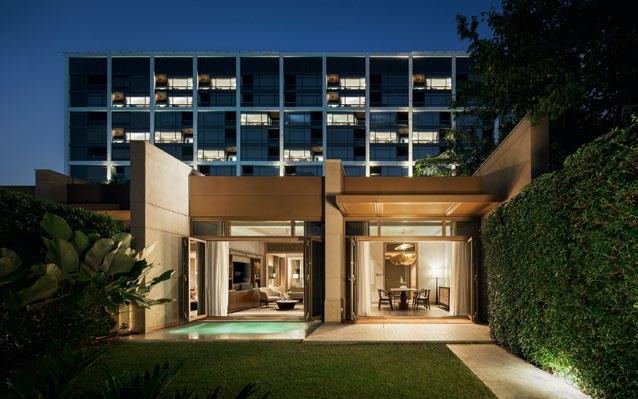
A Capella Culturist is assigned to every guest, crafting tailored neighbourhood experiences and
Revitalising river-lapped hydrotherapy at Auriga Wellness, with rotating lunar-inspired treatment
A curated collection of cultural immersions, including long-tail boat excursions, local craft workshops, and riverside meditation.
At the heart of Bangkok’s premium commercial and retail district, this landmark hotel sits beside the revered Erawan Shrine and links directly via Skywalk to luxury malls and key transport hubs. With 380 rooms and 44 suites, Grand Hyatt Erawan Bangkok blends contemporary Thai design sensibility with sweeping city views. Dining spans nine restaurants and bars, from Thai afternoon tea at the Erawan Tea Room to contemporary Italian and French favourites. While the i.sawan Residential Spa & Club offers a restorative escape with tailored wellness therapies. For meetings, incentives, and events, more than 3,330sqm of adaptable venues deliver both scale and polish. Its centrality, intuitive service, and understated sophistication make it the perfect urban stay.
The Grand Club Lounge privileges include private check-in, evening cocktails and personalised concierge.
i.sawan Residential Spa & Club features villa-style treatment suites, a holistic lifestyle club, outdoor garden terrace, and a 25-metre pool.
Direct skywalk connectivity to Bangkok’s luxury shopping quadrangle: Erawan Mall, Gaysorn, CentralWorld, and BTS Chit Lom interchange.


On the banks of the Chao Phraya River, where Bangkok’s pace slows to the sound of water lapping and longtail boats drifting past, you’ll find Four Seasons Hotel Bangkok at Chao Phraya River, a sanctuary that marries riverfront calm with urban sophistication. The hotel’s 299 rooms and suites open into light-filled spaces with floor-to-ceiling windows, and many look directly onto the water or lush courtyard gardens. Dining ranges from Cantonese refinement to rooftop cocktails, while wellness extends beyond the spa into lap pools and a dedicated kids’ club. With direct river access and stylish meeting spaces, the hotel is equally suited for discerning business gatherings and relaxed escapes
Art-led riverfront estate with design by Jean-Michel Gathy and a curated contemporary art program throughout the property.
Diverse gastronomic dining and bar concepts, including Michelin-starred Yu Ting Yuan and awardwinning BKK Social Club.
Dedicated wellness zone featuring a multi-storey spa, lap pool, and tailored movement and mindfulness
Set along vibrant Sukhumvit Road with direct skybridge access to BTS Skytrain Nana, this 273room hotel places guests in one of Bangkok’s most connected districts. Rooms and suites are fresh and contemporary, while Regency Club accommodation adds tailored privileges for elevated stays. Dining is relaxed and cosmopolitan, and the rooftop Spectrum Lounge & Bar brings a polished social scene with sweeping skyline views. With adaptable venues for meetings and gatherings, Hyatt Regency Bangkok Sukhumvit offers an effortless blend of comfort, connectivity, and city-smart convenience
Skybridge access to BTS Skytrain Nana makes the city instantly reachable.
The 24-hour fitness centre and outdoor pool offer cityscape views, making workouts or wind-downs feel less routine and more revitalising.
The hotel often collaborates with nearby galleries and cultural initiatives, giving guests access to neighbourhood-rooted experiences beyond the hotel walls.


In an address defined by prestige, overlooking the verdant sweep of the Royal Bangkok Sports Club and anchored on Rajadamri Station, The St. Regis Bangkok positions itself as the capital’s refined standard-bearer. With 176 rooms and 52 suites, each offering butler service and expansive views of city or golf-course green, the hotel balances ritual and elegance. Dining spans Michelin-calibre sharing experiences at IGNIV to signature afternoon tea at The Drawing Room and crafted cocktails at The St. Regis Bar. Wellness is elevated via the Longevity Hub by Clinique La Prairie, while meeting-rooms and event venues accommodate both discreet executive forums and grand celebrations
Bespoke relish-butler service.
Direct skywalk access to Rajadamri Station and elite
The Astor Ballroom includes a 15 metre-wide 8K LED screen and venue capacity up to 500 guests.
In the whispers of Jaipur’s palaces and the shimmer



Rajasthan’s twin jewels, Jaipur and Udaipur, offer a journey into the heart of royal India, where history, culture, and luxury converge. Jaipur, the Pink City, bedazzles with its majestic palaces, ornate forts, and bustling bazaars, reflecting centuries of regal grandeur. Udaipur, the City of Lakes, enchants with serene waters, romantic palaces, and timeless architecture, evoking a fairy-tale elegance. Visiting these cities present a tapestry of experiences and an encounter with Rajasthan’s enduring soul.



of Udaipur’s lakes, Rajasthan’s regal legacy unfolds
Jaipur, the resplendent Pink City of Rajasthan, stands as a magnificent testament to centuries of royal grandeur and architectural brilliance. The city’s signature rosehued facades, which earned Jaipur its affectionate moniker, glow warmly under the desert sun, inviting travellers to step into a world where history and luxury intertwine seamlessly.
At the heart of Jaipur lies its palatial splendour from the ornate courtyards of the City Palace to the ethereal façade of the Hawa Mahal, each monument exudes an elegance that transcends time. Amber Fort, perched majestically atop rugged hills, offers panoramic views of the city and a glimpse into a world of mirrored halls, frescoed chambers, and royal ceremonial spaces that once hosted the Maharajas and their courts. The city’s streets, lined with vibrant bazaars, are alive with the colours of handcrafted textiles, intricate jewellery, and artisanal treasures; each piece a testament to Jaipur’s enduring craftsmanship.
Beyond its visual grandeur, Jaipur seduces the senses with culinary indulgence, where traditional Rajasthani delicacies are served with unparalleled finesse. Festivals, music, and performances further animate the city, offering immersive glimpses into its rich cultural tapestry.
Jaipur is a journey through time and taste, a place where luxury and heritage coalesce, and every experience is curated for the discerning traveller seeking the extraordinary. Here, the spirit of royalty lingers in every corner, waiting to be discovered.





















































































Jaipur, was founded in 1727 by Maharaja Sawai Jai Singh II, and stands as a living testament to the magnificence of Rajasthan’s royal past. The city was meticulously planned with precision, symmetry, and an eye for enduring beauty, where every palace, fort, and haveli whispers tales of opulence. Here, the legacy of the Rajput rulers is not merely preserved in stone; it is woven into the very soul of the city, offering travellers a luxurious immersion into centuries of culture, art, and regal lifestyle.
At the heart of Jaipur’s cultural and heritage legacy lies the City Palace, a sprawling complex that seamlessly blends Rajput and Mughal architectural elegance. Its ornate courtyards, intricate balconies, and delicate frescoes reveal the artisans’ devotion to detail, while the palatial museums safeguard treasures of royalty: ceremonial weapons, embroidered textiles, and portraits that capture the regality of Jaipur’s erstwhile rulers. Every hall and gallery tells a story of history that transcends time, allowing visitors to step into a realm where luxury and tradition intertwine effortlessly.
No visit to Jaipur is complete without marvelling at the Hawa Mahal, or Palace of Winds, an ethereal façade carved from rose-pink sandstone. Its latticed windows were designed to grant royal women a private view of the bustling streets below, a reflection of the city’s traidion and architectural ingenuity. The interplay of light and shadow across its honeycomb-






Jaipur’s cultural tapestry is equally vibrant, woven with threads of music, dance, and craftsmanship
like structure creates an almost poetic spectacle, especially as the first rays of dawn illuminate the delicate carvings.
The heritage of this city extends beyond grand palaces to the Amber Fort, perched majestically on a hill overlooking Maota Lake. Here, travellers are invited to experience the splendour of Rajput royalty in a setting that fuses defensive strength


























































with artistic finesse. Mirror-studded halls, ornate gates, and elaborate frescoes speak of a time when warfare and beauty coexisted harmoniously; offering a narrative of power and elegance that is uniquely Jaipur. A luxury experience at Amber Fort often includes elephant rides through the fort’s massive ramparts, private guided tours, and exclusive access to hidden chambers.
Jaipur’s cultural tapestry is equally vibrant, woven with threads of music, dance, and craftsmanship. The markets overflow with crafted ware and culinary traditions. It is a journey into the hands and hearts of Jaipur’s artisans.
Ultimately, Jaipur is more than a city, an experience of timeless cultural magnificence. Its streets, palaces, and bazaars exude a sophistication borne of centuries of royal patronage, inviting travellers to explore, indulge, and immerse themselves in a heritage that continues to shine with unparalleled brilliance. From the pink-hued streets to the mirrored halls and artisanal treasures, Jaipur offers a deep dive into the past, rendered luxuriously for the discerning traveller seeking both history and elegance.





































Jaipur has emerged as one of the world’s premier MICE (Meetings, Incentives, Conferences, and Exhibitions) and wedding destinations, blending regal history and modern luxury. Its unique combination of cultural richness, world-class infrastructure, and immersive experiences makes it a destination that caters to business and leisure travellers seeking unforgettable events.
One of Jaipur’s greatest assets is its stately beauty. The palaces, forts, and havelis provide breathtaking backdrops for weddings, corporate retreats, and gala events. Venues such as Rambagh Palace, Jai Mahal Palace, Samode Palace, and Nahargarh Fort offer unparalleled luxury, combining historical elegance with modern amenities. Imagine a gala dinner under a canopy of twinkling lights at a centuries-old palace, or a corporate conference in a grand ballroom adorned with intricate Rajasthani frescoes, the city transforms any event into a memorable, opulent experience.




























The palaces, forts, and havelis provide breathtaking backdrops for weddings, corporate retreats, and gala events
Jaipur’s luxury hospitality sector is another driving factor. The city boasts an array of five-star hotels and resorts equipped with cutting-edge conference facilities, banquet halls, and personalised services that cater to the nuanced demands of events. International brands seamlessly integrate local aesthetics into their spaces, providing state-of-the-art technology alongside traditional elegance. Whether hosting an intimate board meeting or a large-scale celebration, Jaipur’s hotels ensure flawless execution with unparalleled hospitality.
Accessibility also positions Jaipur as a global MICE and wedding destination. The Jaipur International Airport connects the city to major Indian metros and international hubs, while well-maintained highways and









































rail networks facilitate convenient travel for domestic and international guests. This ease of access, combined with Jaipur’s rich cultural tapestry, makes it an ideal location for corporate delegations and destination weddings. Sustainability also contribute to Jaipur’s global reputation. Many venues now emphasise eco-conscious practices, while the staff are trained to provide world-class service, ensuring peace of mind for both organisers and attendees.
Cultural experiences further enhance Jaipur’s appeal. Guests can indulge in heritage walks, royal dining experiences, hot air balloon rides, and traditional craft workshops, adding layers of engagement beyond formal events. A MICE group might conclude a conference with a curated Rajasthani cultural evening, while wedding guests can enjoy folk performances, elephant processions, and lavish royal feasts, ensuring every event resonates with local authenticity.
Jaipur is also renowned for its luxurious wedding offerings. The city consistently ranks among the world’s top destination wedding locations due to its ability to host extravagant multi-day celebrations. From pre-wedding functions like mehndi and sangeet to grand wedding ceremonies and post-wedding brunches, Jaipur delivers unmatched elegance. High-end planners in the city provide bespoke services, from curated décor reflecting royal heritage to personalised entertainment and gourmet catering.
Furthermore, Jaipur’s shopping and culinary
scene complements its MICE and wedding appeal. International visitors are drawn to the city’s vibrant markets.
In essence, Jaipur is a destination that transforms events, making it an unrivalled choice for those seeking unique and immersive experiences. With every event steeped in rich history and meticulous planning, it continues to hold a place among the world’s most coveted destinations.




























































Each piece is a testament to Rajasthani craftsmanship, blending traditional motifs with contemporary elegance










Jaipur, the vibrant Pink City, is a shopper’s haven, where colour, culture, and craftsmanship intertwine in a sensory feast. The markets combine generational artistry with traditional Rajasthani charm, making every visit memorable through India’s rich heritage.
For those enchanted by aromatic spices, Jaipur’s Tripolia Bazaar and Nehru Bazaar are essential destinations. These bustling lanes are alive with the heady fragrance of saffron, cardamom, turmeric, and chili, alongside exotic spice blends unique to Rajasthan. Shoppers can select hand-packed, high-quality spices, perfect for recreating authentic Indian flavours at home or as gifts imbued with local authenticity.
When it comes to handwoven carpets and textiles, the markets of Bapu Bazaar and Johari Bazaar are unparalleled. Here, artisans display intricately patterned rugs and dhurries, showcasing centuries-old weaving techniques in vibrant colours and luxurious textures. Each piece is a testament to Rajasthani craftsmanship, blending traditional motifs with contemporary elegance.
Jaipur is also a world-renowned destination for jewellery. Johari Bazaar stands at the heart of the city’s gem trade, offering Kundan, Meenakari, and polki jewellery. Necklaces, bangles, rings, and earrings sparkle with regal sophistication, embodying the royal aesthetic of Rajasthan. These handcrafted treasures are perfect for collectors or anyone seeking a statement piece steeped in heritage.
For local artifacts and handicrafts, Chandpole Bazaar and Tripolia Bazaar are overflowing with carved wooden items, brassware, pottery, and miniature paintings. Each item is carefully crafted by skilled artisans, offering a tangible piece of Jaipur’s cultural story.
Shopping in Jaipur is more than an acquisition. The vibrant streets, lively banter of vendors, and kaleidoscope of colours create an enchanting atmosphere. From fragrant spices and opulent carpets to glittering jewellery and exquisite artifacts, it offers a shopping adventure that celebrates artistry and mastery.













































































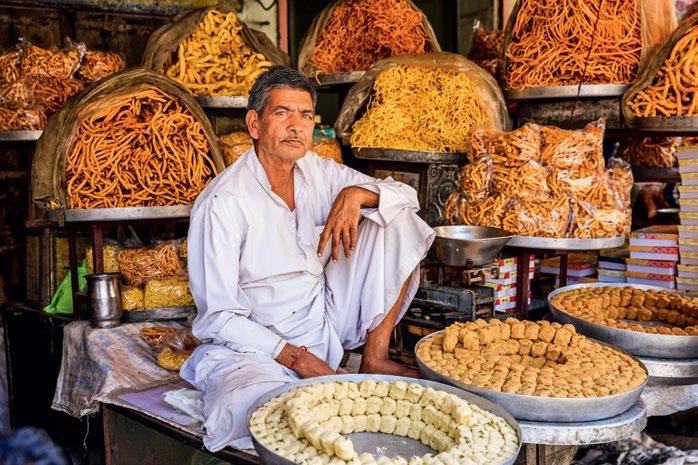



Jaipur is not only a feast for the eyes, but also a destination where the senses are indulged through an eclectic culinary tapestry. Here, centuries of royal patronage and cultural fusion have given rise to a cuisine that is as lavish as the city’s palaces, yet deeply rooted in tradition. Every meal in Jaipur tells a story of spice-laden markets, ancient cooking techniques, and a heritage of flavours carefully preserved through generations.
The city’s streets are a vibrant showcase of Jaipur’s gastronomic richness. From the aromatic stalls of Johari Bazaar to the bustling lanes near Bapu Bazaar, travellers encounter the intoxicating scents of freshly fried pakoras, sweet jalebis, and smoky chaats that have delighted locals and visitors for centuries. Each bite is a celebration of texture, colour, and spice, reflecting Jaipur’s ability to marry the playful with the regal in every dish.
The royal kitchens, once reserved for Maharajas, continue to inspire today’s gastronomic encounters. Heritage hotels and palatial restaurants offer meticulously curated menus featuring Rajasthani classics such as dal baati churma, gatte ki sabzi, and
In Jaipur, gastronomy is not merely an activity, it is a journey where every meal becomes an unforgettable encounter with the city’s soul
laal maas, often prepared using traditional methods passed down through generations. Dining here is a sensory immersion into the city’s cultural legacy, where presentation, aroma, and taste are elevated to an art form.
Beyond the savoury, Jaipur tempts the sweet-toothed traveller with its rich confections: ghevar, mohanthal, and rabri, each offering a taste of Rajasthan’s royal indulgence. For those seeking elevated experiences, private culinary tours and cooking workshops provide the ultimate indulgence, allowing travellers to explore spice markets, engage with master chefs, and even participate in the preparation of age-old recipes.
In Jaipur, gastronomy is not merely an activity, it is a journey where every meal becomes an unforgettable encounter with the city’s soul.





















































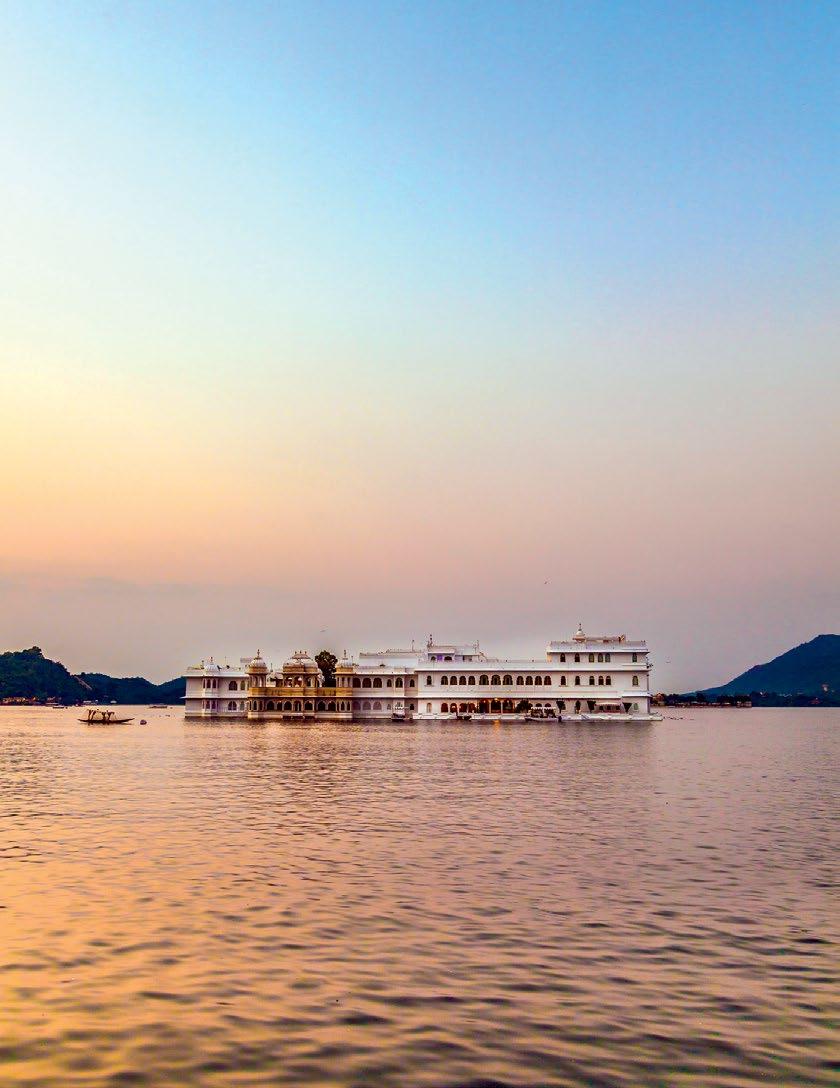
Udaipur, the City of Lakes, is a vision of romantic splendour, ensconced in the Aravalli hills of Rajasthan. Often described as a living painting, this enchanting city reflects the majesty of its royal past in every shimmering waterway, ornate palace, and tree-lined boulevard. With its serene lakes mirroring the opulent palaces that grace their shores, Udaipur exudes an ethereal beauty that captivates travellers seeking luxury and cultural immersion. Each corner of this city tells stories, that honour age-old traditions.
At the heart of Udaipur’s allure lies architectural marvels with cascading balconies, delicate jharokhas, and intricately designed courtyards that reveal the artistry of Rajput craftsmanship. The City Palace is a gateway into the regal lifestyle of Udaipur’s Maharajas, offering an intimate glimpse of royal history. Beyond the palace, the city’s lakes Pichola, Fateh Sagar, and Udai Sagar create a serene setting for indelible experiences, from private boat rides beneath the glowing palaces to lakeside dining that merges heritage and gastronomy.
Udaipur’s cultural heartbeat extends into its vibrant bazaars, artisan workshops, and culinary traditions which reflect a heritage meticulously preserved over generations. Festivals, music, and dance animate the city, providing a living canvas of its traditions and artistry.
In Udaipur, every experience is curated for rejuventation and relaxation: whether strolling along tranquil lakesides, exploring majestic palaces, or savouring heritageinspired cuisine, the city promises a journey into romance and magnificence.

Stepping into Udaipur is like entering a living painting, where every corner reflects the grandeur of Rajasthan’s royal past. Apart from the scenic magnificence, the charm lies in the way its heritage and culture are woven into the very fabric of daily life. The city carries the legacy of the Mewar dynasty, whose rulers shaped its palaces, temples, and traditions with an eye for artistry and elegance.
The first thing that strikes a visitor is the architectural splendour. The City Palace, towering above the serene waters of Lake Pichola, is a labyrinth of balconies, courtyards, and ornate halls. Walking through its corridors, one can almost hear echoes of royal ceremonies and courtly music that once filled the air. The intricate mirror work, marble carvings, and delicate frescoes are not just decorative, they tell stories of valour, devotion, and extravagance. Across the lake, the Jag Mandir and Jagdish Temple stand as further testaments to Udaipur’s rich heritage, their stone carvings and domes reflecting centuries of devotion and craftsmanship. Udaipur’s lakes are the heartbeat of the city. The gentle lapping of water against the ghats, the reflection of palaces on the tranquil surface, and the boat rides at sunset create moments of magic. These lakes; Pichola, Fateh Sagar, and Udai Sagar have witnessed royal processions, festivals, and daily rituals for generations, blending natural beauty with cultural history.




















the City of Lakes, is a vision of
the
Every evening, as the sun sets over the shimmering waters, it feels as if the city is taking a quiet, graceful bow to its past. Culture in Udaipur thrives in music, dance, and festivals. The city pulses with folk traditions, from the swirling movements of Ghoomar to the expressive storytelling of Bhavai. During festivals like the Mewar Festival, the streets burst into a riot of colours, processions, and music, offering glimpses into traditions that have been nurtured for centuries. Local musicians play the sarangi, dholak, and ravanhatta, their melodies echoing tales of heroism, love, and devotion. These performances are not mere entertainment; they are living narratives of Udaipur’s soul, connecting the past with the present.
Art and craft form another vibrant layer of Udaipur’s cultural identity. Miniature paintings, meticulously detailed and painted by hand, capture scenes of royal life, mythology, and nature. Artisans continue to create pottery, textiles, and silverwork using techniques passed down through generations, ensuring that tradition lives alongside modernity. Walking through local


































































































markets, one can feel the pulse of these crafts, each piece a story, each design a fragment of history.







Udaipur’s culinary heritage also delights the senses. Traditional Rajasthani dishes like dal baati churma, gatte ki sabzi, and sweet treats like ghevar are infused with the flavours of royal kitchens, local produce, and centuries-old recipes. Eating in Udaipur is like is tasting history and taking a bite of culture.
In Udaipur, heritage is not frozen in time; it is alive, breathing through lakes, palaces, festivals, music, and crafts. To walk its streets is to step into a world where the past is celebrated in the present, creating a timeless experience that touches the heart and the imagination.

Tucked away amid bejewelled lakes and regal palaces, Udaipur has emerged as one of India’s most sought after destinations for grand weddings and high end corporate gatherings. The city’s unique blend of heritage ambience, luxury hospitality and scenic splendour has turned it into a dual purpose event capital where romance and business converge in settings of extraordinary beauty.
For weddings, Udaipur’s ascendancy is unmistakable. The city’s palatial venues, pristine lakeside lawns and heritage forts serve as the perfect backdrop for destination celebrations. Over 30 luxury venues in Udaipur are now globally recognised, and approximately 90% of major destination royal weddings in the region take place at these landmark settings. According to recent data, Udaipur hosts over 1,000 destination weddings annually and the market value for such weddings in the city has climbed sharply, reflecting a surge in demand for luxurious, curated celebrations.
The sheer scale of the phenomenon has made wedding tourism a major economic contributor to the city’s hospitality and service sectors. On the MICE front, Udaipur is replicating its wedding success by catering to corporate travellers and event planners seeking refined venues with character. Luxury hotels in Udaipur report that while weddings continue to dominate revenue, but MICE is also gaining substantive traction











































































































































with enormous banqueting spaces, state of the art conference facilities and open air lawns now serve with distinction.
What sets Udaipur apart is not just its infrastructure, but the intangible sense of place. Couples and corporations are drawn here by the idea of celebration immersed in tradition, elegance and unmatched photo worthy scenery. Whether it’s a sunset ceremony on a lake island palace, or a board meeting amidst terraced gardens, Udaipur delivers ‘event luxury’ on many levels.
meetings. Hospitality brands are responding and properties are designed with event scale in mind, offering multiple large format venues, high end décor, tailored experiences and dedicated event teams.







Accessibility, upgraded connectivity and an expanding inventory of premium hotels have all contributed to its rise. The ripple effects are significant: local artisans, decorators, florists, wedding planners and event service providers are all thriving, driven by this vibrant business of celebrations and
In essence, Udaipur has transcended being simply a scenic getaway to a destination where heritage and human connection align to create cherished event experiences. From lavish weddings that echo royal legacies to incentive trips and conferences wrapped in cultural richness, Udaipur is the canvas on which grand moments are crafted. For the event planner, corporate marker or soon to wed couple, Udaipur offers a setting where every detail, every vista and every gathering is curated not just for function, but for elegance, memory and impact.
Shopping in Udaipur is not for the fainthearted; it is not only a serious commitment to retail therapy but it is also an indulgent journey into the royal heart of Rajasthan, where every marketplace glimmers with colour, and charm. The city’s bazaars are an exquisite tapestry of sound and scent, with the air laced with the fragrance of sandalwood, the shimmer of silks, and the sparkle of handcrafted silver.
As you wander through the winding lanes of Hathi Pol, you are greeted by a dazzling array of miniature paintings, their intricate brushstrokes capturing regal processions, delicate peacocks, and serene lakes. Each piece feels like a whisper from the past, painted with the same precision once reserved for royal courts. The market hums with life, shopkeepers in vibrant turbans invite you with warm smiles, their stalls overflowing with colourful textiles and hand-embroidered garments that seem to glow in the soft desert sunlight.
A stroll through Bada Bazaar reveals an opulent feast for the senses. Here, the rich textures of Bandhani and Leheriya fabrics sway gently in the breeze, their hues echoing the splendour of Rajasthan. The delicate clinking of silver jewellery fills the air: necklaces, anklets, and bangles crafted with timeless skill gleam like treasures from a bygone era. Each piece tells a story of tradition and generational craftsmanship, making shopping in Udaipur feel like curating your own collection of royal heirlooms.























For those seeking that extra touch of suavity, boutique stores near Lake Pichola and the City Palace offer luxury reinterpretations of Rajasthani design with silk scarves hand-dyed in jewel tones, intricately carved marble décor, and artisanal perfumes reminiscent of palace gardens.
Shopping in Udaipur is not about hurried purchases. It is about savouring beauty, heritage, and elegance. Every object holds a soul and every moment feels like a scene from a royal dream.

























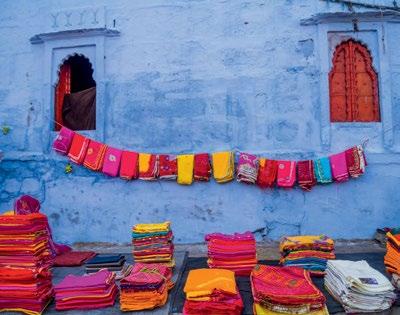






Every object holds a soul and every moment feels like a scene from a royal dream
























To dine in Udaipur is to revel in the essence of Rajasthan’s royal culinary heritage, where every meal tells a story of artistry and indulgence. The city’s gastronomic landscape is as captivating as its palaces and lakes, offering an indelible blend of regal flavours, local ingredients, and age-old recipes perfected in the kitchens of Mewar’s kings.
Begin your journey in the narrow lanes of the old city, where the air is rich with the aroma of spices with cardamom, cumin, and ghee mingling in a heady symphony. Street vendors serve piping-hot kachoris, mirchi vadas, and jalebis, golden and glistening, offering a delicious introduction to Udaipur’s vibrant food culture. Each bite captures the warmth of Rajasthani hospitality; bold, aromatic, and full of heart.
For a more indulgent affair, the city’s royal restaurants and lakeside terraces transform dining into an experience of grandeur. Imagine savouring dal baati churma, the quintessential Rajasthani dish, served with rich lentils, crisped wheat dumplings, and sweetened crumble, all against the shimmering backdrop of Lake Pichola. The still waters reflect the glow of the City Palace as traditional music drifts softly through the evening air, a feast for the senses in every sense.










































































































Udaipur also celebrates its culinary diversity with an elegant fusion of traditional and contemporary flavours. Rooftop lounges and boutique hotels reinterpret heritage recipes with modern artistry, think rose-infused desserts, saffron-laced curries, and locally sourced wines. Even a simple cup of masala chai enjoyed on a sunlit terrace becomes an act of serenity and pleasure.
In Udaipur, food is a revered ritual of grace and connection. Each flavour, each aroma, and each meal is a journey through time, echoing the royal spirit and timeless charm that make this city a true connoisseur’s paradise.
The nuances of an enchanting festive soirée for the holiday season









The Lalique Silex Bowl, a transcendent crystal creation, transforms light, shadow, and reflection into a mesmerising, luminous ballet. Paired with the Riedel Horn Decanter, whose sculptural form channels liquid with seamless grace, the duo exemplifies the pinnacle of artistry. Satin-polished crystal, meticulously faceted surfaces, and flowing contours evoke a dialogue between elemental nature and masterful craftsmanship. Both resonate with strength and delicacy, elevating them into sculptural artistry. They embody a symphony of form, light and beauty where every detail is an ode.
Shaped by millennia, flint bears the quiet memory of the Earth; its facets a dialogue of strength and fragility. Lalique transforms this primordial poetry into crystal, where the Silex Bowl becomes the vessel as well as the sculpture. Satin-polished and worked with meticulous, multi-faceted finishes, each surface plays with light, shadow, and reflection, revealing tactile and visual textures. This Lalique opus evokes a living landscape frozen in crystal; its forms unpredictable, organic and exquisite. Every curve and facet create a masterpiece where nature’s rawness is transposed into timeless and enduring artistry.



Modelled on the coiled elegance of a musical horn, the Riedel Horn Decanter immortalises the family’s Central European heritage, echoing the iconic insignia of the Austrian Post. Crafted in crystal of flawless clarity, its sinuous silhouette is adorned with a regal golden-yellow stripe, bordered by two black lines that trace its graceful curves. Ingeniously designed with dual openings for double decanting, it enhances both young and aged wines, coaxing out clarity, smoothness, and depth. Each decanter is painstakingly handmade by master glassmakers.



Elevate every celebration with the St. Louis Thistle Champagne Bucket, a masterful creation transforming chilled champagne into a luminous spectacle. Complemented by the Diptyque Golden Pyramid Candle Holder, whose gilded facets exude warmth and radiance, the ensemble evokes an ambience of opulence. Each piece harmonises artistry and function. Together, they embody the pinnacle of luxury entertaining with sparkling crystal and golden luminescence, where every detail is a testament to curated, enduring elegance.




The St. Louis Thistle Champagne Bucket, blown and masterfully cut in Saint-Louis-lès-Bitche, Moselle, France, is a celebration of heritage. Born in 1913 from the inspiration of the 1909 Chardon service, its name was Anglicised to ‘Thistle’ reflecting generational lineage and the iconic botanical motif delicately engraved along its frieze. Adorned with Venetian-style stripes, precise bevel cuts, and enriched with 24-carat gold or platinum, each parison radiates luminosity. For over a century, the Thistle collection has graced the tables of connoisseurs, transforming moments of celebration into ritualistic elegance. Every facet and gilded accent captures light, rendering the champagne bucket a sublime embodiment of savoir-faire.

Intricately crafted in Italy from luminous borosilicate glass by master artisans, the Diptyque Golden Pyramid Candle Holder is a definitive statement of perfection. Its radiant pyramid form inspired by Desmond Knox-Leet’s iconic logo, transforms candlelight into an infinite play of golden reflections, casting a celebratory warmth and glow. Each piece is unique, showcasing a dialogue between contemporary elegance and centuries-old Italian glassmaking traditions. Founded in 2008, Casarialto emerges from the sublime union of time-honoured mastery and visionary contemporary design. At Casarialto, modern sensibilities marry techniques refined to perfection over generations. Culminating in creations that embody the essence of artistry, they create an unmistakable aura of festivity.
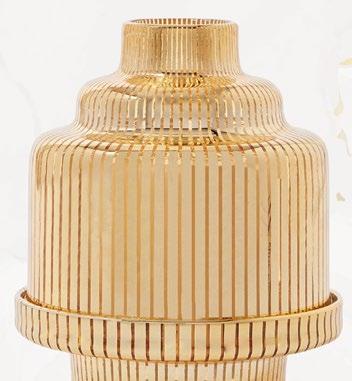

Transcend the art of dining with the Hermès Mosaique au 24 Gold Set of Five Square Plates, transforming each setting into a tableau of distinction. Accompanied by the Baccarat Harcourt Empire Flute, that embodies the pinnacle of luxury entertaining, they create a symphony of artistry and tactile pleasure, where every edge, every facet, and every glint of gold or crystal celebrates the artisanal excellence of these legendary maisons.



Exquisitely crafted in France and designed by Benoît-Pierre Emery, the Mosaique au 24 Gold Set of five square plates is the pinnacle of maestria. Each porcelain plate is adorned with hand-applied mosaics, meticulously screen-printed and accented with 24-carat gold tiles. Delicate ochre and pale grey tesserae, punctuated by radiant gold cabochons, compose graphic motifs that elegantly fuse Art Deco sophistication with the grandeur of ancient Greece. At the heart of each plate, the iconic Hermès monogram ‘H’ pays homage to the illustrious Faubourg SaintHonoré heritage. This quintet of square plates transforms every dining experience into a celebration of immortal design, handcrafted artisanship, and resplendent extravagance, reflecting the very essence of Hermès.

A sublime reinterpretation of the collection’s regal heritage, The Baccarat Harcourt Empire Champagne Flute was first conceived in 1841. It holds the distinction of being the oldest design in the Baccarat archive, celebrated for its iconic and eternal form. Each flute is adorned with delicate golden embellishments, where faceted crystal surfaces traced with golden highlights are wrought with impeccable finesse. A radiant gold ring crowns the rim, while the geometric, bevelled stem exudes classical sophistication. The hexagonal foot, intricately trimmed in gold, grounds the design with subtle refinement. Together, every facet, bevel, and gilded detail transforms each flute into a luminous testament to heritage and the pinnacle of crystal luxury.
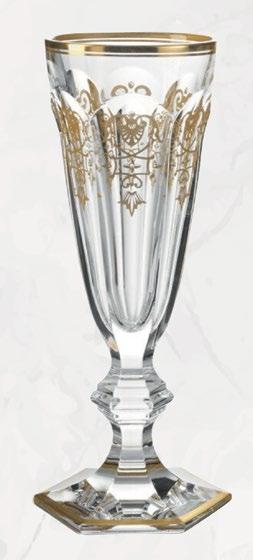

Embodying French decorative tradition, The Ercuis Louis XV Jardinière is where ornate curves and intricate silverwork evoke the elegance of the royal court. Each detail is sculpted with masterful precision, transforming florals or centrepieces into radiant works of art. In perfect harmony, the Waterford Gilded Napkin Rings capture the same spirit creating a tableau of finesse, where heritage meets modern splendour, and every glint of silver and gold speaks to the enduring beauty of artisanal perfection.
The Prestige Collections imbue the intrinsic soul of Ercuis, uniting emblematic creations that showcase the dexterity of its master silversmiths. Within the workshops, where gestures of excellence have been lovingly preserved since 1867, each piece is born from a legacy of precision. Originating in France’s golden age of silversmithing, the Louis XV style, or Rocaille, remains one of the most imaginative expressions in the decorative arts. It is defined by fluid asymmetry, entwined arabesques, and delicate motifs of shells, foliage, and blossoms. The Louis XV Jardinières, signature pieces of Ercuis, epitomise this classic majesty. Each, a radiant fusion of heritage and French silversmithing.



The Waterford Mastercraft Aran Napkin Rings encapsulates the art of refined celebration, transforming the table into a stage of iridescent charm. Handcrafted in Ireland from the finest lead-free crystal, each piece reveals the exquisite Aran pattern; its intricate lattice inspired by craftsmanship and the textures of woven artistry. Gilded accents trace the contours with a soft, golden glow, reflecting Waterford’s mastercraft philosophy where generational tradition meets sculptural perfection. With their radiant clarity and enduring strength, these napkin rings are a final flourish of regality, designed to enhance intimate gatherings and momentous occasions into experiences of resplendent luxury.

The Oggetti Veneziani Champagne & Silvery Gold Orsini pattern exudes Venetian intricacy, where gilded motifs capture light with brilliance. Its geometry and lustrous finish transform it into an unparalleled ritual. In perfect harmony, the Christofle MOOD Gold flatware complements this tableau with sculptural distinction, each piece kissed with 24-carat gold and flawlessly balanced. They create a resplendent setting turning each dining experience into a personification of grandiosity. Every detail exudes peerless refinement.



This customizable table runner, crafted with pointed ends, is a sublime fusion of heritage and contemporary craftmanship. Handwoven in Fortuny fabric, the iconic Orsini pattern shimmers in champagne and silvery gold hues, its surface delicately framed by a refined gold trim tracing every edge. Fully lined in sumptuous Rubelli satin, it drapes with effortless grace, marrying tactile luxury with visual poetry. Fortuny textiles, celebrated as one of the world’s most revered houses, transcend mere fabric; they are living echoes of style and cultivated taste. Every table adorned with this masterpiece becomes a stage for resplendent gatherings, where elegance and luxury converge in perfect harmony.



The MOOD collection with a lavish 24-carat gold accent adorning its sculptural, egg-shaped chest and exquisitely wrought flatware elevates dining to a fine art. Each piece exemplifies masterful artistry, where contemporary design converges with the magnetism of gilded perfection. The delicate play of light across polished surfaces transforms every fork, knife, and spoon into a resplendent jewel, reflecting both poise and modern refinement. This curation of six; table forks, table knives, table spoons, and coffee spoons offers a complete harmony of elevated taste. Perfectly balanced and visually striking, the MOOD flatware becomes a manifestation of cultivated and enduring discernment.




Notch up your festive hosting with Buccellati and Asprey London, where impeccable craftsmanship meets enduring finesse. The Buccellati Rouche Coasters are hand-chased to create a delicate ripple texture that captures the shimmer of candlelight and the spirit of Italian luxury. The Asprey London Sterling Silver Stag Head Place Card Holders bring a regal touch to your tablescape, evoking the grandeur of British heritage. Both transform every celebration into an extraordinary affair.
The Stag Head Place Card Holders in sterling silver by Asprey London exemplify the art of entertaining. Each piece is a miniature sculpture, featuring an impeccably crafted stag head that captures the noble grace and majesty of this timeless emblem of strength. Handcrafted and hallmarked in Asprey’s London workshops, the holders reflect the Maison’s enduring dedication to British heritage, precision, and artistry. Polished to a lustrous sheen, they lend an air of regal sophistication to any formal dining occasion. More than elegant accessories, they are conversation pieces; an expression of Asprey’s union of classic design, modern luxury, and enduring distinction.







The Rouche Silver collection draws inspiration from a motif long celebrated in its high jewellery creations. Translated into pure silver, the Rouche design reveals an exquisite interplay of light, texture, and movement, each delicate ripple meticulously hand-chased by master silversmiths. This intricate detailing, reminiscent of lacework adorns the borders of vases, trays, and coasters; pieces that have become true icons of the Maison’s heritage. The result is a celebration of Italian craftsmanship and sculptural mastery, where every contour reflects Buccellati’s distinctive aesthetic.






































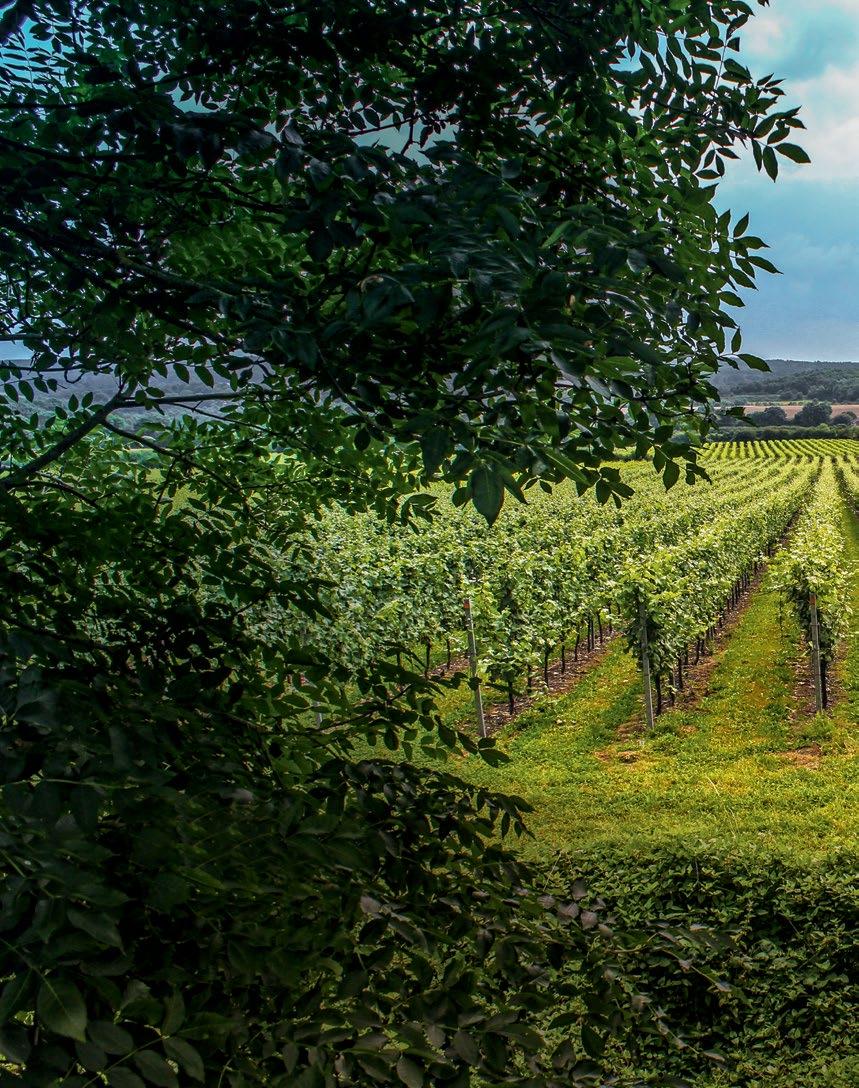







Across Europe, vineyards reveal that terroir is more than terrain; it’s the continent’s culture, craft, and character distilled

There’s a kind of silence that settles over a vineyard at dusk. The hum of the day softens, and the vines seem to exhale. Somewhere, a cork eases free, not with a pop, but with a sigh, and suddenly the air smells faintly of oak and rain. That stillness, that ritual, is what wine travellers chase across Europe: a rare alignment of landscape and spirit, and the feeling of being briefly in tune with time itself. Across Spain, France, and Italy, the great triumvirate of the Old World, vineyards have evolved far beyond their postcard allure. For the global professional in motion, they offer a different kind of luxury: space to think, to connect, and to rediscover rhythm. Wine tourism in Europe has matured beyond the weekend tasting. It’s become an art form of its own, a blend of design, gastronomy, and sustainability that speaks to travellers who value authenticity over excess. To visit these regions today is to see how heritage evolves without losing its heart.































Spain approaches wine like it approaches art, with conviction, colour, and a refusal to be predictable


Spain approaches wine like it approaches art, with conviction, colour, and a refusal to be predictable. Its landscapes are bold, its wines unapologetic, and its winemakers quietly rebellious. In its vineyards, centuries-old cellars now stand beside bold architectural experiments that seem to rewrite the horizon. In Rioja, Frank Gehry’s flowing titanium at Marqués de Riscal reflects both sunlight and ambition; Santiago Calatrava’s Bodegas Ysios ripples like a sculpted skyline of its own.
But beyond these showpieces lies something more elemental. In La Rioja Alta, small family bodegas still practise crianza; ageing wines patiently in American oak, with a focus on counting years rather than just profits. In regions like Ribera del Duero, Priorat, and Rías Baixas, new generations are reclaiming native varietals, rethinking organic farming, and inviting travellers to join the process. They are welcomed into dimly lit tasting rooms where the air smells of cedar and history, and where conversation flows with the same ease as the garnacha in their glasses.
In Andalusia, the narrative shifts again. Here, amid the white villages of Jerez and the golden coast, sherry tells a story of sun, salt, and serendipity. Winemakers speak of flor, which is the delicate film of yeast that forms on maturing wine, as if it were a living being. For the visitor, tastings unfold like performance art: the flick of a venencia tool, the swirl of amber liquid, followed by applause for the perfect pour.
Spain, in essence, is a study in contrasts. Its vineyards invite travellers to toggle between the ancient and avant-garde, between design hotels and historic haciendas, where there’s space to work, reflect, and connect.

To speak of wine is to talk of France. It’s where viticulture first became vocabulary: terroir, cru, and assemblage. But even the classics evolve. Modern French wine tourism has learned to pair its centuries-old savoir faire with something more experiential, more personal.
In Champagne, limestone tunnels that once hosted royalty now welcome travellers for candlelit dinners, sound installations, and tastings that reveal how soil, weather, and willpower shape every bubble. In Bordeaux, the Cité du Vin rises beside the Garonne like a decanter turned into architecture, a museum, tasting lab, and cultural manifesto in one.
Further east, Burgundy remains quieter and more deliberate. Here, vineyards are parcelled like chessboards, each climat (microterroir) whispering its own personality. Each parcel of land has its own identity; even a small walk can take you across centuries of classification. Tastings happen in hushed cellars, the host often a fourth-generation vigneron whose palms are permanently stained from harvest.
And then there’s Provence, where rosé has graduated from a summer indulgence to serious art. Vineyards here invite travellers for yoga sessions among the vines, followed by Provençal lunches where conversation drifts as lazily as the afternoon light. What unites these experiences is discipline in decadence. French winemaking is not about grandeur, but rather about proportion. Each detail, from the barrel’s toast to the slope’s angle, reflects an almost architectural pursuit of harmony. A morning tasting might segue into a lunch of oysters and Chablis on the terrace of a Michelin-starred inn; an afternoon might lead to a truffle hunt or a spa treatment using grapeseed oil from the estate’s own vines. For the traveller accustomed to boardrooms and flight itineraries, France offers a different metric of success: precision as pleasure, mastery as mindfulness.































Modern French wine tourism has learned to pair its centuries-old savoir faire with something more experiential, more personal



Wine here is not a performance; it’s a pulse woven into the rhythm of life itself

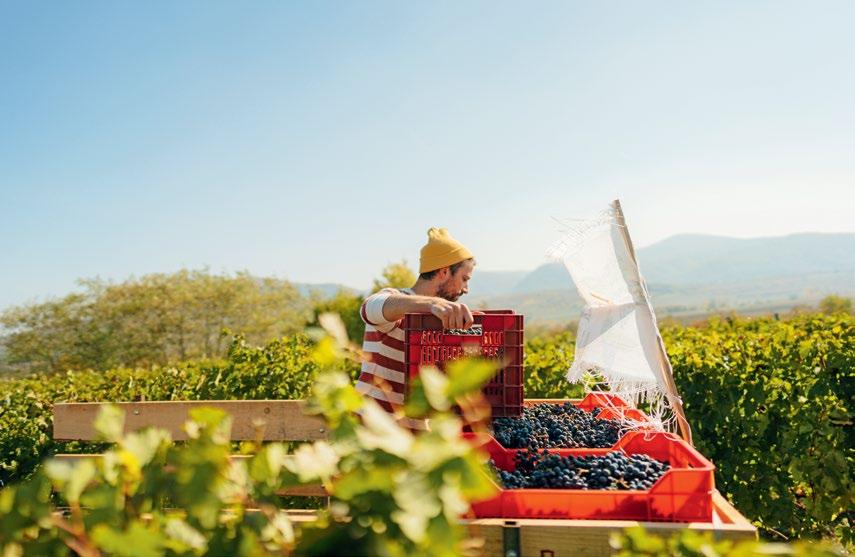
Italy doesn’t separate wine from life; it pours one into the other until they’re inseparable. To experience this is to realise that every glass tells a story of people, not processes. Wine here is not a performance; it’s a pulse woven into the rhythm of life itself.
In Tuscany, mornings smell of dew and espresso, and the countryside seems to breathe in golden tones. The Chianti hills roll like soft linen, dotted with stone villas where barrels rest in cool, candlelit cellars. Agriturismos, farm stays that marry rustic charm with contemporary design, invite travellers to experience vendemmia, the harvest, side by side with the growers. You crush grapes with your feet, stain your hands purple, and sit down to plates of pecorino and pappardelle as the winemaker’s children chase the dog between rows of vines.
Further north, in Piedmont, the mood grows introspective. Barolo and Barbaresco, the so-called ‘wines of kings’, mirror the landscape and are complex, brooding, and layered. Nebbiolo grapes demand patience, and the people who make them have learned to wait. For visitors, tastings are less about technique and more about storytelling, with families recounting wars survived, seasons lost, vintages that changed everything.
Further south, Sicily redefines resilience. On the slopes of Mount Etna, new-generation winemakers are coaxing minerality and myth from blackened soil, redefining the island’s image.
Italy’s secret is its intimacy. It welcomes you not as a consumer but as a co-conspirator in joy. You linger longer, drink slower, talk louder. And when you finally leave, you realise you’ve tasted not just wine, but the very idea of la dolce vita!
Wine tourism has become one of the most quietly lucrative sectors in European travel, yet it thrives on the illusion of effortlessness. Behind the romance lies infrastructure, boutique hotels with conference-ready lounges, and hybrid estates that merge workation amenities with vineyard immersion. The high-flying executive who
once squeezed in a tasting between meetings now seeks to host the meeting at the estate itself.
Across Spain, France, and Italy, that fusion of leisure and leadership is redefining luxury. At Abadía Retuerta LeDomaine in Ribera del Duero, a restored monastery turned five-star retreat, guests toggle between vineyard tours and boardroom sessions. In Provence, Châteauneuf-du-Pape’s estates have begun offering wellness residencies where meditation and viticulture intertwine. Tuscany’s Castiglion del Bosco, which is owned by a family synonymous with fashion, lets guests taste private vintages bearing their names.
The new buzzword isn’t ‘exclusive’. It’s immersive. Travellers aren’t seeking distance from the world, but a deeper connection to it. Sustainability has also become imperative: solar-powered wineries, organic soil practices, and low-intervention fermentation.
To trace a glass of wine from vineyard to table is to trace the evolution of travel itself, from acquisition to experience, from escape to belonging. In the Old World, where every hill seems to tell a story, the greatest luxury is time: the patience to let things mature, the privilege to pause.
Spain invites reinvention. France teaches restraint. Italy celebrates the release. Together, they form the perfect flight of a journey that begins in ambition and ends in stillness.
For the modern traveller, this is not about collecting labels or ticking off appellations. It’s about tasting intention, the craftsmanship, the climate, and the character behind every pour. Because in the end, the best bottle isn’t the most expensive one. It’s the one that reminds you where you are and how you got there.

A
festive table of global flavours, where tradition, memory and family gather
as one
Around the world, Christmas dinner is far more than a festive meal, it is a joyful pause where families slow down, gather close, and celebrate the people who shaped them. The flavours may change from table to table, but the feeling remains universal: a sparkling mix of laughter, music, clinking cutlery, and stories retold. Treasured recipes, often handwritten and gently worn with history, are brought out with excitement, linking generations through memory, migration and tradition.
















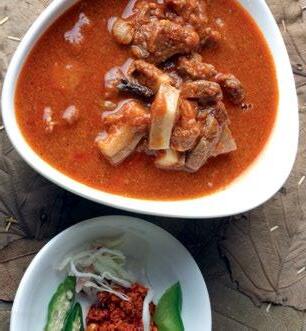












In Goa, Christmas unfolds in a vibrant fusion of ancient Catholic tradition and coastal Indo-Portuguese culture. Streets glow with star-shaped lanterns, and carol groups visit homes with guitars, violins and the unmistakable rhythm of the Goan jive. Historic churches host midnight Mass, drawing entire neighbourhoods into community worship. Homes are meticulously decorated, nativity scenes are proudly displayed, while children delightedly show off new Christmas dresses and suits bought specially for the season. Celebrations continue with festive balls, beach dances and neighbourhood open-house parties. What truly distinguishes Christmas in Goa is its openness, families of every faith join in the festivities, making the holiday an expression of shared joy and harmony.
The Christmas dinner in Goa is more than just a meal, it is a sensory celebration, deeply influenced by Portuguese culinary heritage and the region’s coastal larder. At the centre typically lies sorpotel, a spicy pork dish slow-cooked with vinegar, garlic







and local spices, served alongside sannas, soft steamed rice cakes with a gentle sweetness. Families often prepare roast duck or roast pork, marinated overnight for tenderness and richly seasoned with Goan masala. Seafood remains essential, with prawn curries and recheado-stuffed mackerel adding fragrant complexity to the table. In many homes, vindalho makes an appearance too, its tangy spice sharpened by toddy vinegar. Goans end their meal with an abundance of sweets known collectively as Kuswar: bebinca, the iconic layered coconut-milk pudding, dodol, kulkuls and neureos filled with jaggery and nuts, each made in elaborate family batches, often days in advance. Homemade feni, wine and liqueurs accompany the meal, keeping spirits lively as music plays in the background. As cousins crowd into kitchens, elders share stories and plates return for seconds, the feast becomes a reflection of Goa itself- warm, layered, spicy, joyfully generous and bound by legacy, turning the dinner table into a celebration of memory as much as flavour.




Londoners know Christmas is near when the city starts to glow from the inside out. It begins with a chill in the air and the comforting smell of something baking. A bus window fogs as strangers share a laugh about the weather, and a brass quartet plays beneath the clock at Covent Garden, their notes lifting with visible breath. The Thames reflects the shimmer of Southbank lights, and pubs spill soft warmth onto the pavement each evening. Families pull scarves higher, children count down school days, and couples wander home from winter markets with paper bags of mince pies. It’s not the grandeur but the small, ordinary moments that make London feel festive, a city of quiet rituals and shared cheer. By the time midnight carols echo from Westminster, even the fog seems to hum along.
The British tradition of curating their Christmas dinner evolved gently through the centuries while still echoing Victorian influences. The main course consists of the roast: most commonly
turkey, sometimes goose, rubbed with butter and herbs, roasted until crisp and deeply aromatic. It is accompanied by sage and onion stuffing, Yorkshire puddings, herb-flecked roast potatoes, parsnips glazed in honey and sprouts tossed with chestnuts or pancetta. The gravy is rich, velvety and poured generously over the plate, while bread sauce adds a creamy softness that feels uniquely British. Cranberry sauce brings brightness and balance, cutting through the richness like a festive ribbon of tartness. Tables often include pigs-in-blankets; sausages wrapped in bacon, so beloved they have become Christmas icons. For Londoners, the meal is not complete without crackers snapped over laughter, paper crowns slightly askew on heads. Dessert arrives with ceremony: Christmas pudding doused in brandy and set aflame, accompanied by custard or fresh brandy butter. Later, the cheese board appears with Stilton and chutney, followed by mince pies, mulled wine and the slow, cheerful sprawl of family conversation.






























































There’s no subtlety to Christmas in New York, it arrives like a Broadway overture.
Somewhere between Thanksgiving and the first flurries, the city shifts gear. Windows turn to stages, lined with snowflakes cut from paper and sequins, while coffee carts trade iced brews for peppermint steam. The Rockefeller tree looms like a promise, its lights reflecting off taxi roofs and hurried smiles. Uptown, a doorman hums Sinatra beneath his breath; downtown, a street preacher sings louder than the traffic. No one escapes it, not the late-night waitress refilling mugs, nor the cab driver who hangs a red ribbon on his mirror. Even Wall Street softens, its stone edges glowing in the early dark. The city that never slows finally pauses, just long enough for people to look up and remember why they live here at all.
The city’s mosaic of cultures, and blended tradition is seen in its Christmas dinner, where most tables have a roasted turkey or glazed ham, lacquered in honey, cloves and brown sugar
until richly caramelised. Brisket often appears in homes influenced by Jewish holiday cooking, braised low and slow with onions until fork-tender. Italian-American families serve Feast of the Seven Fishes, ranging from calamari to baccalà, paired with linguine in vibrant tomato sauce. Alongside these staples, sides are exuberant: sweet-potato casserole crowned with toasted marshmallows, maple-glazed carrots, green beans with almonds and pillowy dinner rolls. Stuffing varies wildly- sourdough in the West Village, cornbread uptown, sausage-studded versions in Brooklyn brownstones. Cranberry relish brightens every plate. New Yorkers slice through pumpkin pie, pecan tart, chocolate-cream pie or imported panettone for dessert. Cheesecake, especially from Brooklyn, makes an inevitable appearance. After dinner, families sip eggnog dusted with nutmeg, hot apple cider or neighbourhood-made mulled wine while board games stretch late into the night.


Christmas in Naples feels like it’s been simmering all year, waiting to spill over. The city bursts into celebration with the same intensity it lives every day. The smell of fried dough and citrus peels floats through the air, mingling with car horns and laughter. Streets tighten with life, neighbours shouting greetings, children chasing each other between stalls selling terracotta saints, fishermen, and angels. Shopkeepers call out over the noise, their counters crowded with candied fruit and pastiera pies. At dusk, balconies fill with families, waving sparklers and leaning into the noise below. There’s no neat divide between sacred and ordinary here: presepe scenes sit beside television sets, prayers share space with gossip. At midnight, fireworks scatter over the bay, washing the city in light. Naples doesn’t host Christmas; it becomes it! Full of vibrancy and endlessly generous, like the people who call it home.
Neapolitan Christmas dinners are a feast built on ritual and seasonality. It begins on Christmas Eve with a beloved seafood-forward spread. The table
often starts with fried baccalà (salt cod), crisp smelts, marinated anchovies and seafood salads dressed simply with lemon, parsley and olive oil pressed from local groves. Spaghetti alle vongole- silky, briny and fragrant- takes pride of place, accompanied by platters of fried vegetables and artichokes. On Christmas Day, the flavours deepen: tortellini in brodo appears in many homes, followed by roasted lamb, slow-braised ragù or succulent rolls of veal stuffed with herbs and cheese. Sides are generous with potatoes, winter greens and crusty bread to sweep up every drop of sauce. Dessert is theatrical with struffoli, tiny honey-glazed dough balls studded with candied fruit, form colourful mounds at the centre of the table, while roccocò, mostaccioli and susamielli offer dense, spiced sweetness dipped into espresso or dessert wine. Sparkling spumante brings toasts alive, and lively conversation stretches into card games long after midnight. In Naples, the Christmas dinner plays out like a small opera at the table, full of colour, passion and dishes passed with dramatic affection.



















































SRooted in Alsatian tradition, is what Strasbourg

trasbourg wears Christmas like a crown of light, with hints of storybook splendour. The halftimbered houses seem to lean closer together under their garlands of evergreen, as though the whole city is conspiring in celebration. Strings of golden lights spill across cobbled squares where the Christkindelsmärik, Europe’s oldest Christmas market, hums with chatter and cheer. The air is alive with scent: cinnamon, roasted almonds and mulled wine mingling with the crisp bite of winter. Choirs sing from the steps of the Cathedral, their voices rising against its soaring Gothic arches, while smaller churches glow with candlelight and carols. Families wander beside the Ill River, clutching paper cones of chestnuts, and shopfronts sparkle with teddy bears, wreaths and ribbons. Children press their noses to frosted glass, searching for magic in the displays. Everywhere, warmth spills into the cold, Strasbourg at Christmas is a living postcard, glowing with joy, tradition and togetherness.








Christmas dinners are about. Rustic farmhouse flavours meet refined French touches. Foie gras is served first, spread onto toasted brioche with a whisper of fig compote or spiced chutney. Choucroute de Noël follows- sauerkraut flavoured with juniper and Riesling, crowned with sausages, smoked meats or slow-roasted pork. In many households, poularde (fat, tender hen) or roasted goose takes centre stage, lacquered with butter and herbs until its skin crackles. Goose fat-roasted potatoes, braised red cabbage and spaetzle help anchor the feast, while the table quietly fills with mustards, pickles and crusty bread. Alsatian desserts include bredeles, tiny spiced cookies in countless shapes, make their seasonal debut alongside pain d’épices thick with honey and orange peel. Some families prepare Kugelhopf, its marzipan and almond aroma perfuming the room, while others slice into Bûche de Noël, feather-light and dusted in cocoa. Glasses of local Gewürztraminer or sparkling Crémant d’Alsace lift spirits, lingering through rounds of storytelling.




There’s a kind of golden calm that falls over Lisbon in December. The sunlight turns honeyed, slipping between tiled façades and catching on garlands strung above narrow lanes. Street musicians play soft guitar near Rossio Square, their melodies blending with the scent of roasting chestnuts. Inside pastelarias, windows fog as people linger longer than usual over coffee and conversation. In the evenings, church bells from Bairro Alto ripple across the hills, calling families to Missa do Galo. Afterward, laughter drifts from every doorway, neighbours swapping plates of rabanadas and wine, a child showing off a new toy. There’s no rush, no theatre, just the comfort of rhythm and return. Christmas here feels like sunlight after rain: gentle, unhurried, entirely sincere. Lisbon doesn’t put on Christmas; it invites it in, one candle, one song, one shared meal at a time.
Flavours of the sea anchored in simplicity, patience gives you Lisbon homes on Christmas Eve. Families gather around bacalhau com todos, salt cod gently poached and served with potatoes, cabbage, boiled
eggs, olive oil and garlic. It is humble, comforting and deeply symbolic. The table often opens with caldo verde, a potato and kale soup streaked with chouriço, warming cold December nights. On Christmas Day, roast turkey or cabrito assado (roast kid) appears in many homes, basted slowly until tender. Bowls of rice studded with pine nuts, garlicky grelos (turnip greens) and crisp potatoes round out the feast, with platters passed generously between relatives. Dessert is where Lisbon glows brightest. Rabanadas, the Portuguese cousin of French toast, arrive soaking in cinnamon and sugar syrup, while sonhos, airy doughnut puffs, disappear almost instantly. Bolo Rei, studded with jewels of candied fruit, crowns the table, someone inevitably finding the hidden charm tucked inside. Almond-rich filhós and glasses of Port or Moscatel bring sweet, lingering toasts. Tender and timeless, blending seaside tradition with family ritualslow, fragrant and shared in the warmth of softly lit dining rooms, is the essence of Lisbon Christmas dinners.



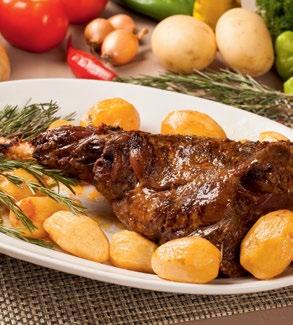






























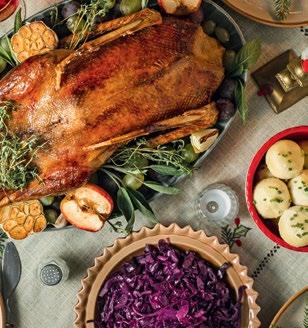



























Creplace it with roasted goose or duck scented with orange peel and thyme, but the rhythm remains gentle. Sides lean earthy: warm potato salads slicked with mustard seeds, buttery bread dumplings and braised red cabbage softened with apple. Platters move slowly around the table, with seconds offered, never insisted upon. As dinner winds down, the table shifts almost seamlessly into dessert.

hristmas begins in Vienna, not with fanfare, but with stillness. The city seems to listen to itself. Church bells sound richer in the cold, echoing between Baroque façades that gleam like porcelain. In cafés, waiters balance trays of melange and apple strudel, and the murmur of conversation feels almost orchestral. Market stalls glow softly, selling candied nuts, glass ornaments and wreaths bound in silk ribbon. Every movement feels deliberate, measured, as if the entire city has learned the rhythm of grace. By evening, the streets are hushed except for the clink of teacups and the low strains of a violin near the Hofburg gates. Vienna doesn’t dazzle; it glows inwardly, a city that celebrates by remembering how to be quiet together.
Christmas dinners are deliberate and majorly rooted in comfort rather than excess. The evening often begins with carp, baked or fried, a tradition tied to old Catholic fasting customs. Some families
Mohnnudeln, poppy-seed noodles dusted with sugar, arrive steaming, followed by bowls of clementines and walnut shells cracked open for luck. Plates of Vanillekipferl and Linzer cookies are passed with small glasses of fruit schnapps or herbal liqueur. Later, coffee is brewed strong and dark, poured into porcelain that only appears once each year. There is little noise, just the sound of cutlery setting down softly and stories told without hurry. Here, Christmas dinner does not need grandeur; it finds its charm in ritual, restraint and a meal shared by people who know one another deeply.


Perfectly poised at Singapore’s most coveted address where Orchard Road’s glamour meets the UNESCO-listed Botanic Gardens and the elegant Embassy District, The St. Regis Singapore personifies iconic grandeur

Where refined service, elevated dining, and executive comfort confluence
What’s it like
At the crossroads of Orchard Road and the Singapore Botanic Gardens, The St. Regis Singapore delivers the brand’s signature blend of timeless elegance and discreet luxury. Steeped in Astorian traditions, from champagne sabrage at dusk to afternoon tea rituals, the hotel exudes a cultivated grandeur that never loses its sense of place. Artlined corridors, bespoke floral arrangements, and attentive butler service create an atmosphere where every detail feels considered. For the discerning traveller, it offers a sanctuary of refinement with Singapore’s cultural and commercial heart at the doorstep.
Rooms
The hotel’s newly renovated 299 guestrooms
and suites reflect elegant and contemporary interpretations of residential luxury, infused with botanical nuances inspired by the neighbouring UNESCOlisted gardens. I stayed in an Astor Grand Deluxe King Room, a 50sqm space in calming tones of blue and aqua, with timber flooring and bespoke furnishings that lent it a private-residence feel. Intelligent touch-panel controls, a casting-enabled

The evening champagne sabrage ritual takes place daily at 6:30pm and is a quintessential St. Regis moment. GOOD -TOKNOW

TV, and potable hot and cold water on tap elevated convenience, while the marble bathroom, complete with a freestanding bathtub, twin vanities, and a walk-in shower, felt indulgent and serene.
Sophia is best known as an Italian restaurant, serving its acclaimed cuisine only during lunch and dinner. My morning began there with a classic breakfast of freshcut fruit, warm oatmeal, perfectly fried eggs, and a cappuccino. The lunch and dinner with a la carte and set menus channels modern Italian cuisine, led by Puglian Chef Angelo Sergio. Expect conviviality, craftsmanship, and a menu that journeys through 11 regions of Italy, served with contemporary flair. The hotel’s dining landscape extends to Yan Ting for refined Cantonese,
VERDICT

A masterclass in luxurious living, where St. Regis transforms every stay into a curated experience.
BEST FOR Travellers who value elegant rituals, tailored service, and elevated dining.
DON’T MISS
A long Italian lunch at Sophia, where tableside touches bring the spirit of Italy to the ‘best address’ in Singapore.
PRICE
From approximately SGD 600 upwards.
CONTACT
29 Tanglin Road, Singapore, 247911 +65 6506 6888 stregissingapore.com
The Tea Room for the Astor afternoon tea ritual, and the St. Regis Bar, where the ‘Time After Time’ cocktail menu is an inspired journey through New York and Singapore, told through five different decades. For events and social celebrations, ten versatile venues, including the pillarless John Jacob Ballroom and the elegant Caroline’s Mansion, cater to everything from highlevel board meetings to 600-guest galas and society soirées. After hours, the St. Regis Spa, 27-metre outdoor pool, and 24-hour fitness centre offer restorative balance. The hallmark St. Regis Butler Service, with personalised packing, pressing, and morning beverage rituals tie the experience together with quiet precision and an ease that almost feels instinctive.
What it’s like
Set within the intimate elegance of Club Lanson at Lanson Place Causeway Bay, Salon Lanson offers a modern European dining experience in a relaxed, timeless space. By day, the room is calm and sunlit, with soft colours and tailored furnishings making it perfect for a long, quiet pause from the city. After dusk, the atmosphere shifts into something more cosmopolitan, with cocktails, conversation, and an understated sense of nighttime sophistication. The setting is polished yet convivial: every detail leaning towards comfort and exuding style.
Food & Drink
Dinner began with a glass of red wine, medium-bodied, smooth, and quietly complex. Notes of dark berries and a subtle hint of spice eased in gently, supported by soft tannins. With a gentle dryness on the finish, it was an easy, elegant
way to settle into the evening.
The lobster bisque arrived warm and deeply aromatic, the kind of dish that instantly promises comfort. Its flavour leaned into a pure seafood richness, the sweetness of lobster coming through clearly without the heaviness that bisques can sometimes fall into. A swirl of crème fraîche gave just the right lift, adding a creamy tang that rounded the bowl beautifully, while chives brought a bright, herbal finish.

The spaghetti aglio e olio continued the theme of simplicity elevated by precision. Each strand was perfectly al dente, coated in olive oil that carried the fragrance of gently cooked garlic. Grilled red prawns introduced a lovely contrast, with their sweetness and light char giving depth to the dish. A sprinkle of red chilli added warmth

GOOD -TOKNOW
Indulge in the cocktail and canapé selection at night, which offers a different way to experience the space.
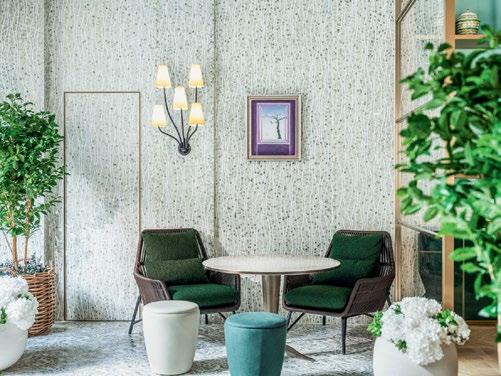

A versatile spot from easy daytime bites to polished evening dining.
VERDICT PRICE
Upwards of HKD 695 for dinner.
CONTACT
133 Leighton Road, Causeway Bay, Hong Kong +852 3477 6888 lansonplace.com
ever tipping the balance. It was a straightforward dish, but executed with quiet mastery that allowed every ingredient to shine. To conclude, I had the classic crème brûlée that delivered pure satisfaction. The caramelised top crackled perfectly, revealing a custard that was cool, silky, and smooth on the palate. Vanilla notes complemented the dish without being overpowering, allowing the dessert to feel indulgent while remaining refreshingly light. It was familiar, beautifully made, and the perfect finale to the experience.
Service
Staff move with intuitive ease, striking a balance between attentiveness and discretion.

A breathtaking revelation of transformation and renewal, offering immersive experiences that transcend an ordinary stay
What’s it like
Grand Hyatt Singapore emerges from an extensive multi-year transformation as a reimagined icon of contemporary splendour and wellness. Situated in the heart of Orchard Road, it offers sophistication curated by dedicated teams. The hotel’s redesigned interiors reveal bold, vibrant spaces, exuding distinct atmospheres that invite energy and tranquility. Amid lush landscaping and a cascading waterfall, this urban oasis is nothing short of an elegant retreat steps from the city’s vibrant pulse. Whether on business or leisure, guests are enveloped in timeless familiarity and comfort.
Offering 699 exquisite rooms and suites, ranging from 42sqm to 252sqm, Grand Hyatt Singapore’s rooms capture the cosmopolitan elegance of Singapore’s cultural fusion. I had the pleasure of staying in the 54sqm Deluxe Club Room, a spectacular escape where contemporary designs blend with indulgent comfort. It features a sleek multipurpose table, an expansive walk-in wardrobe, and a beautifully appointed en suite bathroom complete with a soothing rain shower, Balmain bath amenities, and a dual-sink vanity. Every meticulous detail from furnishings to the ambient lighting
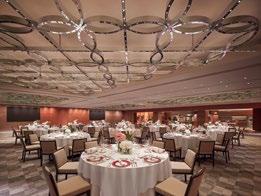

Smart systems optimise lighting and climate control, while waterefficient fittings contribute to the hotel’s Green Mark Platinum certification.
transformed my stay into a truly memorable experience. I also had exclusive access to the Grand Club, where I enjoyed daily refreshments and impeccable service.
Breakfast at The Grand Club was nourishing; freshcut fruits, creamy Greek yogurt, perfectly boiled eggs, and a cappuccino. The newly designed lounge, with warm tones and local artistry, is ideal

A stay at Grand Hyatt Singapore is an impeccably curated experience of extravagance. VERDICT
BEST FOR 16 versatile event spaces spanning three floors.
DON’T MISS
The Halo Steam Room, Hydro Pool, Sauna, and curated outdoor fitness experiences at Damai, the wellness hub.
PRICE
From approximately SGD 479 upwards.
CONTACT
10 Scotts Road, Singapore 228211, Singapore +65 6738 1234 singapore.grand.hyatt.com
to connect, unwind, and reflect. Beyond breakfast, seven distinctive dining experiences captivate discerning palates, inviting guests on a gastronomic journey celebrating culture and craftsmanship; from StraitsKitchen’s vibrant Southeast Asian buffet and the rustic Italian charm of Pete’s Place to Oasis, a stylish poolside retreat. Guests can indulge in contemporary Italian fare at Le Pristine Singapore or savour the iconic afternoon tea at 10|Scotts, now reimagined with an inspired menu. Spanning over 5,100sqm, the hotel’s 16 versatile event spaces include The Grand Salon and The Grand Ballroom. They are complemented by advanced technology and expert teams. At Damai, the Wellness Hub, rejuvenate with holistic spa therapies and outdoor guided fitness experiences.






The sublime and indelible craft of heritage Hokkien mastery
What it’s like
Experience the artistry of Hokkien cuisine at Ming Pavilion in Island Shangri-La, Hong Kong, where heritage and sophistication intertwine. Indulge in a cadence of vibrant flavours, handcrafted textures, and exquisite aromas. Each dish is meticulously composed to honour centuries of culinary mastery from Fujian province. Savour the delicate balance of fresh, seasonal ingredients and time-honoured techniques that celebrate the essence of Hokkien gastronomy. Complement your journey with a curated tea program, featuring rare leaves and bespoke pairings that elevate every bite. Immerse yourself in an atmosphere of contemporary elegance, where every course whispers of the timeless spirit of unparalleled Hokkien dining.
Food & Drink
An exquisite morning unfolded at Ming Pavilion, where tradition met refinement in a Dim Sum Sunday Brunch celebrating the soul of Fujian cuisine.
The experience began with Xiamen-style pan-seared Popiah, its delicate skin embracing a medley


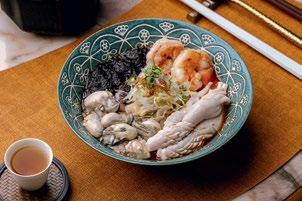

A master class of Fujian sophistication, where culinary artistry, exceptional service, and indelible memories unite in perfect harmony. VERDICT
PRICE
Upwards of HKD 688 per person for 10 dishes.
CONTACT
Level 8, Pacific Place, Supreme Court Road, Central Hong Kong SAR (852) 2820 8580 shangri-la.com
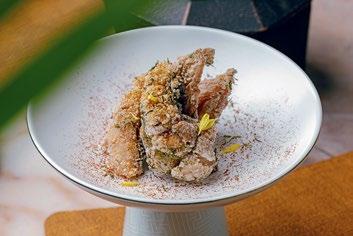
of textures, crisp yet silken. The Yongchun aged vinegar jellyfish terrine offered a graceful dance of tang and umami, while chilled sweet and sour water bamboo strips with pomelo refreshed the palate with citrus brightness.

Tiffany Chan infuses artistry and elegance into every pour, crafting bespoke tea pairings that enchant the senses and elevate Ming Pavilion’s experience.
A Wagyu beef wonton in premium soy sauce unfolded with buttery richness, followed by an oyster pancake crowned with seaweed and baby leek, an oceanic indulgence. The panseared taro dumpling with minced pork and lobster delivered layers of earthy elegance, complemented by the steamed fresh prawn dumpling elevated with a pickled spicy yellow capsicum sauce.
A Xiapu seaweed soup of pork dumpling soothed with
authentic coastal flavours, while the simmered tomato broth of Matsutake mushroom and bamboo fungus imparted a forested fragrance.
The finale, Minnan-style braised taro rice, dried scallop, mushroom, and pork belly, embodied comforting warmth; each grain glistening with savoury depth.
Long after the meal was over, I was content in the lingering of flavours that defined every moment of this delicious extravaganza.
Service
Ming Pavilion epitomises grace with impeccable attentiveness and the warm hospitality of Cantonese sophistication.






An immersive Cantonese dining experience honouring Hong Kong’s heritage through flavour, art, and atmospheric design
What it’s like
Perched on level seven of the Kerry Hotel, Hung Tong is a love letter to old Hong Kong. It is a space where Chef Ken Yu’s modern Cantonese creations meet André Fu’s cinematic design. The red-brick pavilion, vintage leather seating, and softly gleaming metal gates recall the city’s dockside heritage, while views of Victoria Harbour lend a contemporary sheen. It feels atmospheric, polished yet grounded, with the right amount of nostalgia woven through every surface. Daylight brings out the space’s warmth, and by evening, the glow deepens into something quietly sophisticated, perfect for long meals and unhurried conversation.
Food & Drink

An artful blend of nostalgia and modern Cantonese dining, ideal for long lunches or intimate dinners with a view.
PRICE
From approximately HKD 628 upwards for 2 persons.
CONTACT
7/F, Kerry Hotel Hong Kong, 38 Hung Luen Road, Hung Hom Bay, Kowloon (852) 2252 5279 shangri-la.com
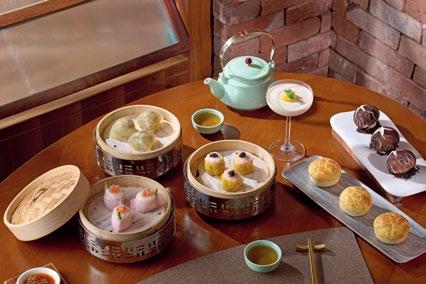
Lunch began with Mantis Shrimp and Minced Pork Dumplings topped with Sturgeon Caviar, a clever play on textures and salinity. The dumpling itself was delicate, the shrimp’s sweetness anchored by the earthy pork, while the caviar added an elegant brininess that lifted the entire bite. It was balanced, confident, and beautifully constructed.

Request a window table to enjoy the harbour views, as the space comes alive as the skyline shifts from day to night.
The Steamed Pork Dumplings with Whole Abalone followed, rich, indulgent, and deeply satisfying. The abalone, tender and full of umami depth, brought a luxurious note to a traditional dim sum staple.
The Stir-Fried Japanese Turnip Cake with Homemade XO Sauce delivered smoky and savoury complexity. Perfectly crisp on
the edges, yielding within, and perfumed with the XO’s signature dried seafood punch. It was a masterclass in restraint and balance.
The Deep-Fried Roasted Goose and Mushroom Puff offered contrast with flaky, golden pastry that gave way to an aromatic, juicy filling. It made for a bite that was both playful and refined, pairing the nostalgia of Hong Kong street flavours with technical precision.
The Barbecued Premium Pork with Maple Syrup brought a soft sweetness to the savoury sequence, the glaze forming a glossy lacquer that cracked under the knife. Each slice carried that perfect charred edge, its richness tempered by the maple’s subtle caramel note.
To close, I savoured the Chilled Mango and Sago Cream with Pomelo. It was refreshing, velvety, and delicately tart. A classic Hong Kong dessert, executed with finesse, it brought the meal full circle: contemporary yet rooted in tradition.
Service
Service is warm and quietly confident; the team guides you through the menu, offering thoughtful suggestions without overshadowing the experience.


Unveiling a dazzling epoch of exquisite gastronomy in Hong Kong’s world of culinary splendour
What it’s like
Marking the world-renowned maestro’s much-anticipated Hong Kong debut, Akira Back at The Henderson ushers in a new pinnacle of epicurean art. Joining an illustrious global portfolio spanning Paris, Dubai, Singapore, and Seoul, this dining destination celebrates Chef Akira Back’s signature fusion of Japanese and Korean artistry, with contemporary American sophistication. Born in Seoul and raised amidst Aspen’s alpine elegance, Chef Back’s extraordinary journey from professional snowboarder to Michelin-acclaimed visionary infuses every creation with passion, precision, and daring innovation. Each dish is a culinary concerto, harmonising bold flavours, refined textures, and inspiring memories drawn from his travels. Immersed in a spirit of discovery, the menu transforms dining into a sensory voyage where artistry, adventure, and emotion converge to enchant the palate and soul.
An evening of sinful decadence began with a pour of Kanonkop Pinotage 2022 from South Africa, its smooth velvety texture and deep
crimson hue set the tone for what was an indelible culinary journey.
The appetizer, AB Salmon Takati with mustard-su miso and pickled wasabi, awakened the senses with its delicate balance of smokiness, tang, and heat that lingered with elegant precision.
Next unfolded The Perfect Storm, a deliciously captivating medley of shrimp tempura, spicy tuna, and salmon belly aburi adorned with chipotle mayo. Each bite delivered an interplay of crisp, creamy, and umami-rich layers which unfolded in a rich symphony of bold flavours and textures. The House Salad, a refreshing interlude of mixed greens dressed in balsamic ginger, provided a gentle contrast; light, aromatic, and exquisitely balanced.
For the main, the Seared Sea Bass arrived glistening, accompanied by earthy shiitake mushrooms and a silken soy beurre blanc, a composition that celebrated both tradition and innovation in every sumptuous forkful.
This unforgettable evening culminated in a decadent finale: the AB Tiramisu, Chef Back’s inspired reimagination of the classic. Espresso-soaked lady fingers, oolong mascarpone, and burnt espresso tea ice cream united
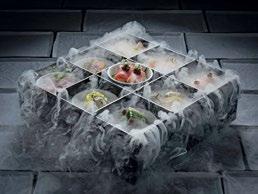


PRICE
Upwards of HKD 1,210
CONTACT
5/F, The Henderson, 2 Murray Road, Central, Hong Kong +852 9733 8988 akirabackhk.com

Young Hee Back, whose masterful artwork graces the restaurant’s walls, is the celebrated mother of Chef Akira Back.
in a dance of deep, bittersweet harmony. This was not an ordinary dessert; one that not only captured mastery, but also artistry, nostalgia, and modern elegance in one transcendent bite.
The service was flawless and artfully choreographed, embodying an indulgent dining experience.
Naina Sarma revisits Bhubaneswar’s evolution, where smart-city ambitions, digital growth, and expanding air routes have reshaped a once-quiet capital into an emerging urban force
Back in 2016, when Business Traveller India examined Bhubaneswar, the city felt poised on the edge of change. It had just been crowned the top-ranked Smart City in the country, the IT corridors were beginning to buzz, and its reputation rested on calm roads, a strong student heartbeat, and a sense of possibility. Nearly a decade later, that early promise has matured, not with fanfare, but with a steady confidence that feels distinctly Bhubaneswar.
In 2016, the Smart City blueprint was still just that, a blueprint. Today, it has translated into a city-wide push for digital governance, safer streets, and clean urban infrastructure. AI-enabled surveillance networks now anchor public safety, while solar-powered kiosks and sanitation upgrades have improved services across underserved pockets. Bhubaneswar’s consistently high placement in national cleanliness rankings reflects this quiet but determined evolution.
INFORMATION TECHNOLOGY
The IT vision of a decade ago centred on the multi-acre campuses rising around Chandaka and Patia. Those foundations have since drawn a deeper ecosystem. Legacy firms have strengthened their presence, new-age companies are testing the market, and startups are finding room to grow thanks to relatively low operational costs and a strong talent pipeline from local institutes. What once felt like an aspiration now feels like a trajectory.
Bhubaneswar’s charm has always been
its balance, unhurried, thoughtful, and confident. That essence remains, but it sits alongside co-working studios, new retail clusters, and rising demand for modern homes. Young professionals and returning NRIs are giving the city a quiet cosmopolitan edge. It still has space to breathe, but now it feels more ready to grow.
In 2016, Biju Patnaik International Airport offered limited connectivity and modest reach. Today, the expansion is unmistakable. New domestic routes have made travel far easier, and the addition of international flights, including Abu Dhabi, marks a meaningful step outward. Plans for a third terminal underline the upward trajectory, hinting at a future in which Bhubaneswar is far better connected to the rest of India and the world.





































